



U.S.

Royal
USA, Eastern
Simmons
Foster Cres.


Ontario, Canada
Canada, Western
Shaddick
West 10th Ave.
BC V6L

Cook

604-619-1777
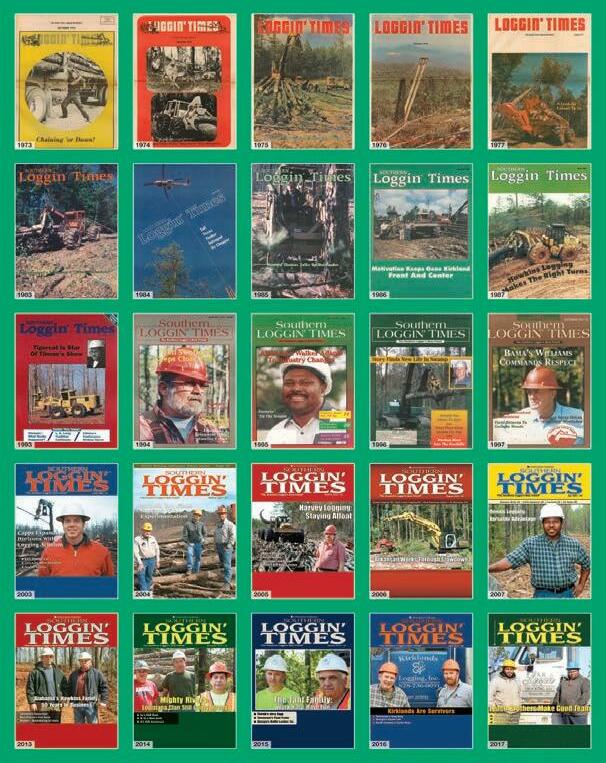






U.S.

Royal
USA, Eastern
Simmons
Foster Cres.


Ontario, Canada
Canada, Western
Shaddick
West 10th Ave.
BC V6L

Cook

604-619-1777


Tidewater Equipment,now a Tigercat dealer,is one of the few companies that has been with Southern Loggin' Times from the very beginning and that is still advertising today.This is their first ad as it appeared in October 1972 in the very first issue of Southern

job she liked at the Attorney General’s office in Montgomery. They were ready to start a family, and didn’t want to leave the house they’d only bought two years earlier. So Bill left Timberjack to try his hand at cutting pulpwood, forming Abbott Logging Co.
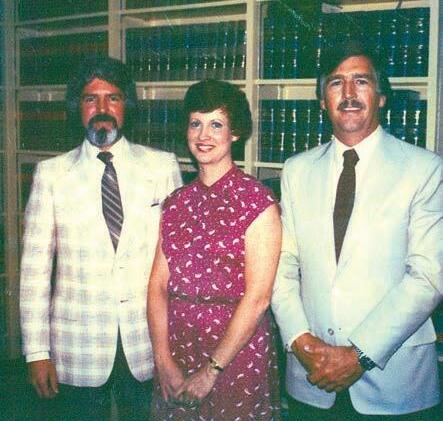

Loggin’ Times was a black-and-white tabloid newspaper for most of its first 10 years; it gradually evolved into something closer to what we all know today. By 1981 it had become Southern Loggin’ Times magazine. Originally touted as “The South’s Only Logging Newspaper,” it grew into “The Southern Logger’s Best Friend.” I can honestly say I think that is what we have strived to be all these 50 years, long before my time and certainly ever since.
ness for more than 20 years publishing timber industry trade journals like Pulpwood Production (later renamed Timber Harvesting). Dianne had been here since 1964, while Dave and DK had joined the team in ’68. But with this new publication, they had a vision for something a little different: it would be an informal, down-to-earth newspaper chronicling the lives and times of the men (and sometimes women) who worked in the woods. It would approach the industry with a personal touch, while providing a forum to not only keep loggers informed on industry happenings but connect them with logging equipment manufacturers and dealers.
That first issue appeared in about 6,000 mailboxes in October 1972. At just 20 pages (nine pages of ads), it bore little resemblance to what we’re all now familiar with, but the fundamentals were there right from the start, the nuts and bolts of the stories, told not so differently then than how we tell it now: your stories, in your words. Loggers might be misunderstood or misrepresented in mainstream media, but here, you could find representation; here, you could be appreciated, even celebrated.
(By the way, if you’re interested in reading a more detailed account on how it all came together from the people who were actually there, DK presented a thorough look in both the 25th anniversary issue in October 1997, and in the 500th issue in May 2014. If you don’t still have those in your collections, call me up and I’ll see if I can’t get you a copy or a PDF of it.)
In 1974, the Timberjack dealer planned to close its Montgomery branch; Kit Avery would move to a company store in Tuscaloosa, where he eventually wound up with Gene Ray Taylor at John Deere dealer Warrior Tractor. They offered my dad an option to move to T-Town, but he didn’t want to pick up roots. His sister and her family lived in Millbrook. Sherry had friends and a

Now I wasn’t born till September 1978, by which time Loggin’ Times was already nearing its sixth birthday. I grew up in that little brick house on Peachtree Street, and like a lot of you, I grew up reading Southern Loggin’ Times. I remember keeping up with the woodpecker and spotted owl controversies in the early ’90s, when I was in junior high. And like many of you I grew up going to work in the woods or the shop with my dad on the weekends and summers. I learned to drive, both skidders and beat up pickups, on old dirt roads, long before it was legal for me to do so. I cleaned belly pans and greased fittings; never quite got the hang of the Prentice knuckleboom but I did spend a lot of hot summer days running a Husqvarna chain saw. On school nights, I helped keep up with the books (so I saw how much money came in and how much more went right back out).
In 1997, just as SLT was marking its 25th anniversary, I was starting college in Montgomery (original plans to study forestry at Auburn dashed by financial limitations). In 1999 I met a girl. Turned out that girl’s mother was Jennifer McCary, whose name my dad and I knew as a writer for Southern Loggin’ Times.
Abbott Logging Co. lasted almost 30 years, but dad had to let it go not long after I graduated college in 2001. Unsure of what path to take and needing income while in graduate school, I started working for Ruby Tuesday in September 2001; I was a bartender, a cook, and eventually a manager. By early 2005 I was thoroughly sick of restaurant work and eager to find something better. Jennifer McCary, who had become my mother-in-law in 2003, let me know SLT was looking for a new writer. Go back to the woods and write about logging? I could do that, I thought.
Turned out I was overconfident. I wasn’t very good at this job, not for a long time. But they took a chance on me, for some reason, and somehow I’m still here, more than 17 years later. I wrote my first Southern Stumpin’ column in 2009, and have been writing it more or less every

month since April 2011. In 2012 I officially became the “shepherd” of SLT. I know I’m a poor substitute for some of those who have gone before me, but I’ve done my best to take good care of it these last 10 years.
the value we bring to buy ads. Take that away and there’s no more SLT, and I’m back to slinging burgers.

Second, it’s you, the readers. If nobody’s reading, then nobody’s buying ads. You’ve always been loyal to us and we appreciate your support. So, we wanted to include both our advertisers and our readers in this issue. A few readers share their stories starting on page 28, and you can see what some of our advertisers submitted starting on page 40.

Finally, it wouldn’t be right if the man himself, DK Knight, didn’t make some contribution to this issue. He was here when it started and he’s still here 50 years later. I mentioned I spent a week or so buried in the archives? DK spent months, deep in research, compiling a history of the entire logging industry. Check it out starting on page 12.
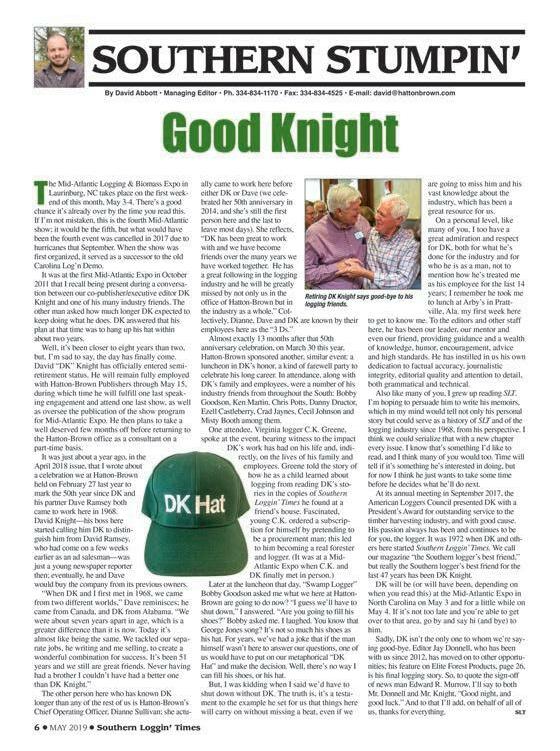

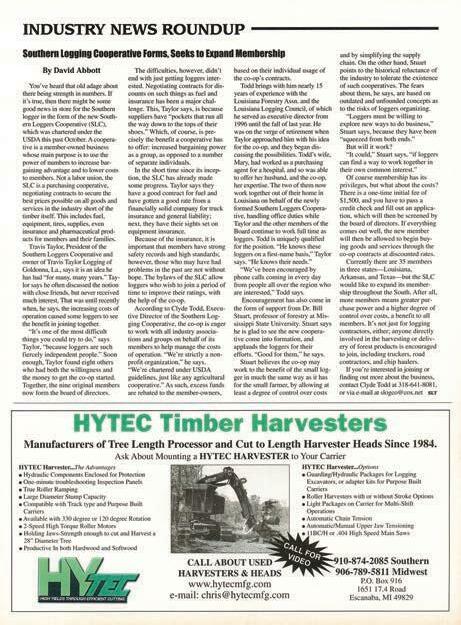

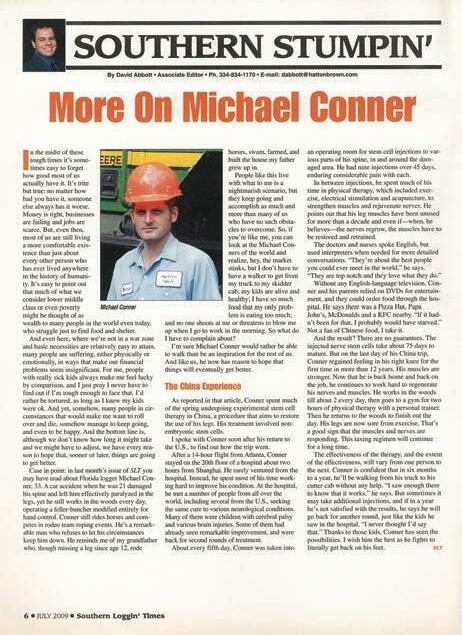
In October 2022, Bill and Sherry Abbott still live at that same little house on Peachtree Street they moved into 50 years ago. A few miles away at Hatton-Brown’s office, Dave, DK and Dianne are still involved with Southern LogDianne is now our chief operating officer, Dave is our publisher and they’re still here most days. As far as I can tell, they’re not going anywhere anytime soon; I’ll retire before they do. As for DK, he officially “retired” three
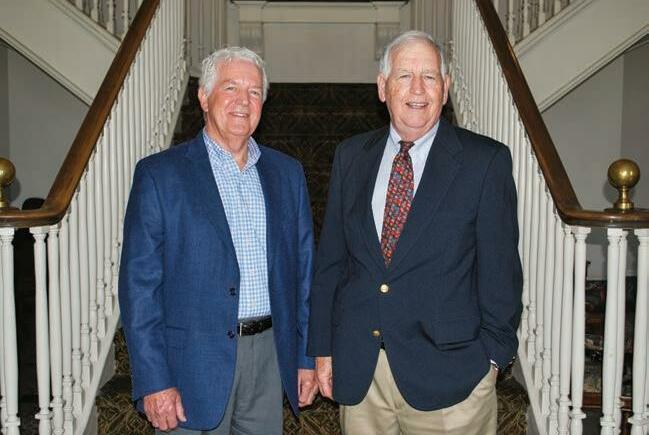
issue was number 391, so by my math I’ve been involved in 210 of those 601 issues. Chances are SLT and me will both be here for a lot more years to come.
SLT
here is only a sample, but I hope you’ll enjoy looking through these images from the past as much as I have.
There are two things SLT exist without. First: our sponsors. You may notice that if you work in the industry, you get SLT for free. There’s no subscription charge, so the only way we make any money, to bring this to you, or to pay our own bills, is because these companies have enough faith in us and in
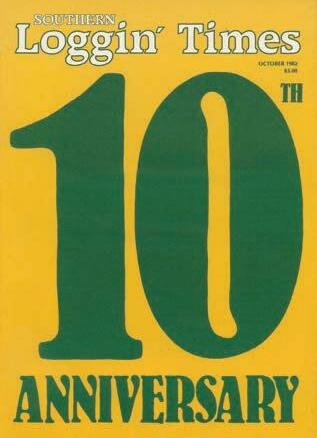

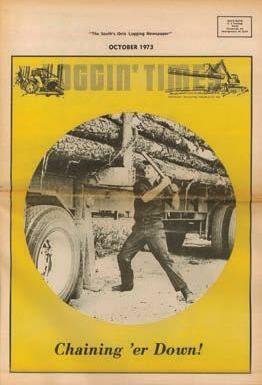

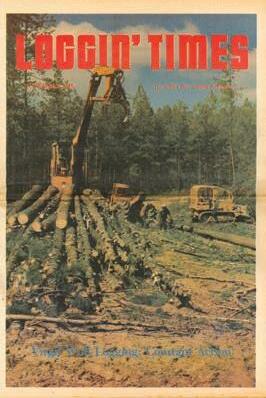
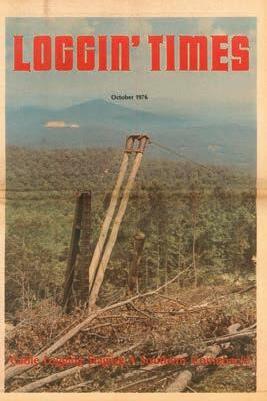
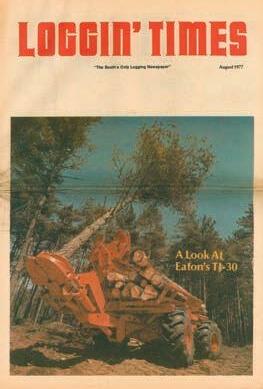
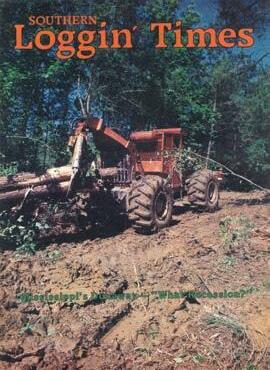
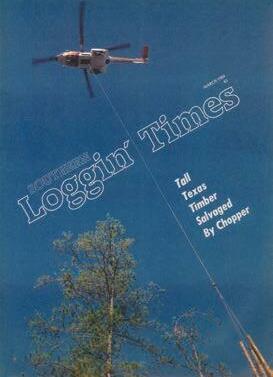
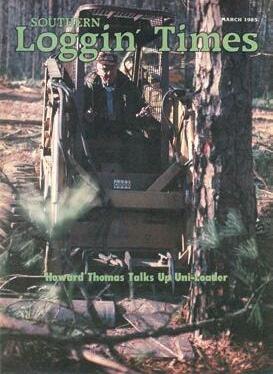

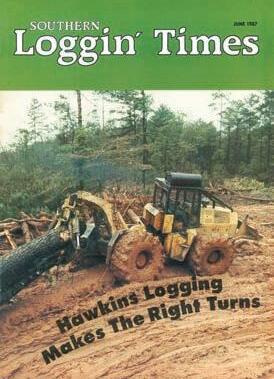
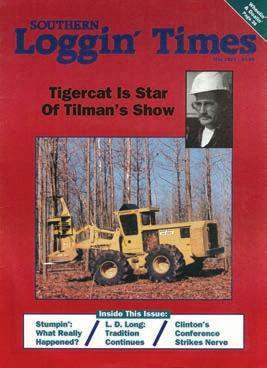
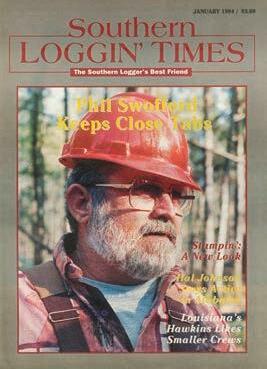

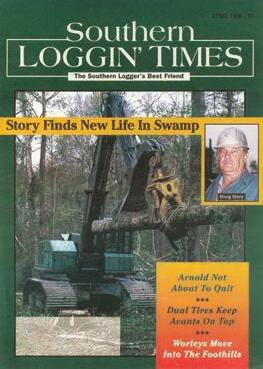

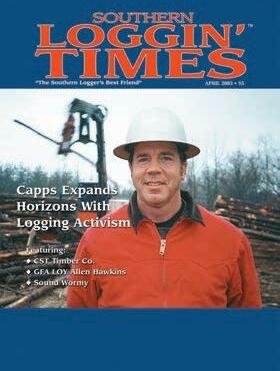
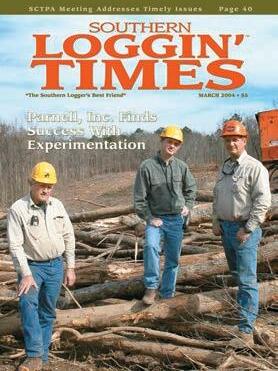

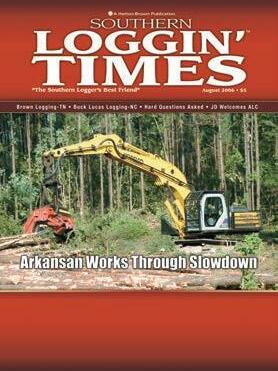
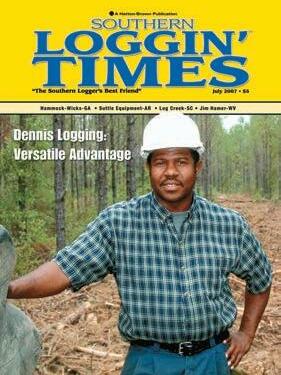


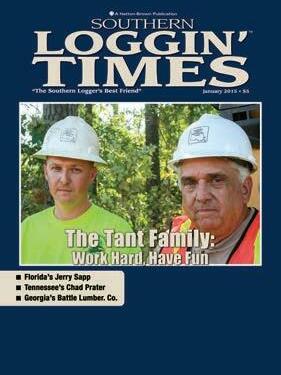
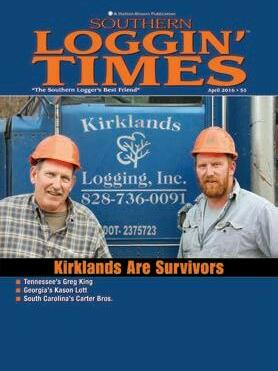

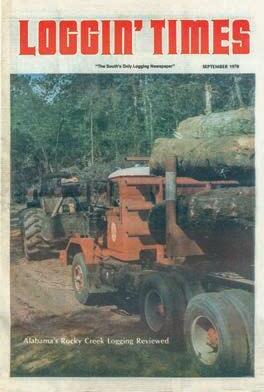
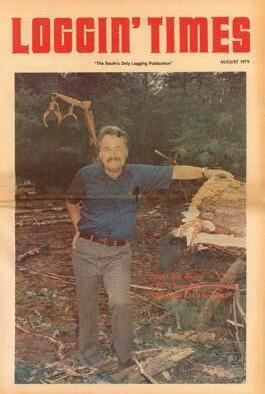
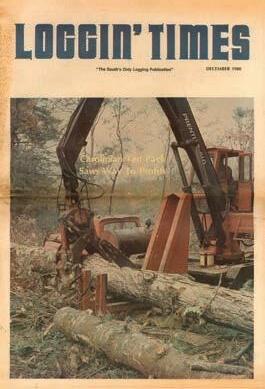
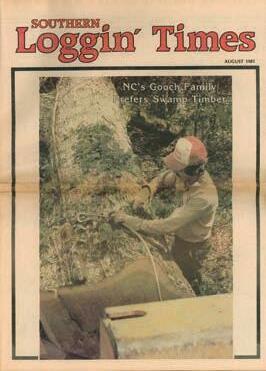

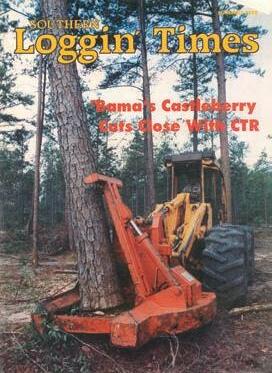



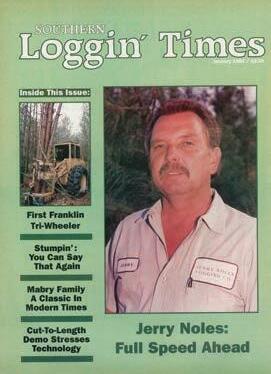

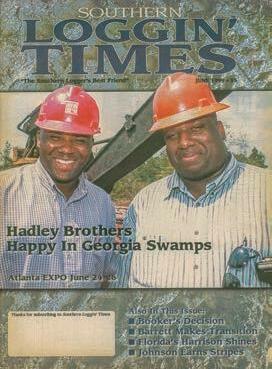


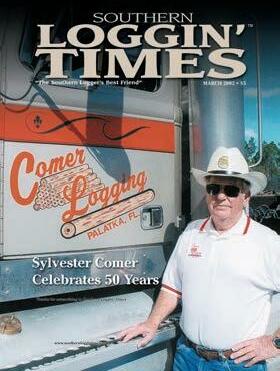
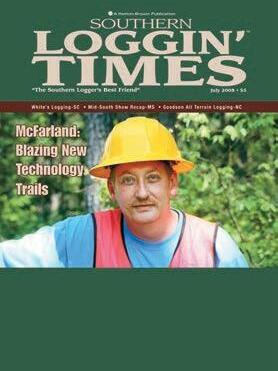
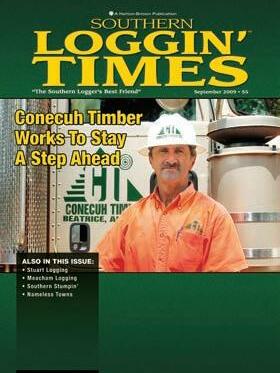

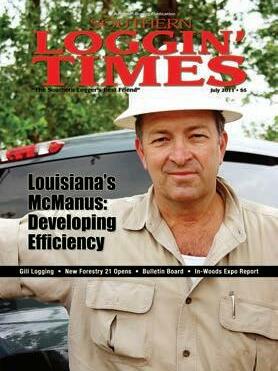





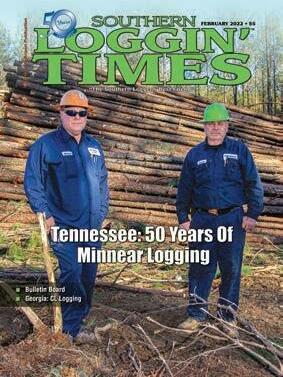
■
By DK KnightOctober 1972 is the birth month of Loggin’ Times, as it was then known.
To help commemorate the magazine’s 50-year anniversary, SLT offers an accompanying and interesting Southern forest industry timeline. But before that year-by-year review begins below, it’s fitting to consider some key developments and trends that occurred after WWII and in the ’50s, ’60s and early ’70s.
As to the timeline itself, events listed are linked to news accounts of the day; however, in some cases events may be off a year or two. Furthermore, some events may have been unintentionally overlooked.
Crosscut saws increasingly were replaced with chain saws, many of them two-man units that were large, cumbersome and often unreliable. Small circle saw contraptions that could both fell trees and buck them were introduced by several companies.
Skidding was largely done by small crawlers, farm tractors, horses or mules. Various types of wagons, carts, trailers and sulkies, some fitted with tracks, were in the mix. Loading was often accomplished with animals and cross-haul chains, but this method was gradually replaced with a truck-mounted mechanical skidder/loader. Think Taylor Logger’s Dream (logs) and Brown Big Stick (pulpwood). Loading pulpwood by hand continued well into the ’60s.
A rigid frame 4x4 wheeled skidder, the FWD Blue Ox, was introduced on the West Coast in 1952. Clark Equipment tested a prototype wheeled skidder in Canada in 1955, and in 1956 Canadian company Timberland Machines Ltd., forerunner to Timberjack, introduced the rigid frame Timber Skidder.
Innovators Leo Heikkinen of WI and the never-say-die Ramey family of MN made gradual improvements to their respective mechanical cable pulpwood loaders and by the late ’50s offered Prentice and Ramey hydraulic
l Gordon Ramey founds Savage Enterprises, introduces Savage KB line.
l McCulloch produces three millionth chain saw.
l U.S. Plywood-Champion Papers becomes Champion International.
l Caterpillar introduces 950 wheeled Tree Harvester.
l Cascade Corp. sheds Ramey KB brand, begins building Cascade branded loaders.
l Forest Equipment Co., Asheville, NC, begins manufacturing FEC Hydro Slasher, a bar/chain unit.
l Omark Industries creates the Prentice Loader Championship.
l Sperry New Holland brings out L-35 skid-steer FB.
and
knucklebooms (KB).
the Southern forest industry.
IP logging engineer Tom Busch developed a prototype hydraulic tree shear for a farm tractor.
Bob Larsen of MN offered a positive-control hydraulic KB, the Swedish-built Hiab. Later he produced his own version, the Hiabob, and eventually sold the product line to Beloit.
Gafner Machine of MI introduced the Iron Mule, a small pulpwood forwarder. Clark Michigan rolled out an articulated wheeled skidder.
St. Regis built the South’s first satellite chip mill for treelength pine at Fargo, GA. More than 600 pulpwood concentration yards were identified in the South.
Two new articulated wheeled skidders, the Pettibone Master 12 and the Garrett Tree Farmer, hit the market.
IP engineers unveiled the Buschcombine, a wheeled short pulpwood harvester that hydraulically delimbed, topped and sheared softwood to short lengths.
Timberjack introduced the 200 series articulated wheeled skidders, building 44 in 1961. Franklin Equipment marketed its first production model wheeled skidder the same year, and John Deere introduced a line of small KB loaders.
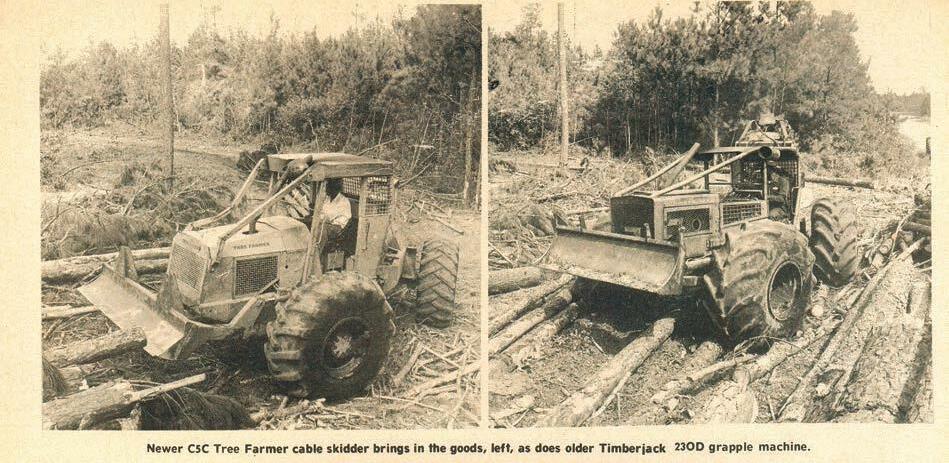
G-P acquired assets of The Crossett Co. of AR for $127 million.
McCulloch produced its one millionth chain saw. Innovator Bob Larsen developed the Beloit Harvester, a tracked machine that delimbed and topped a tree before felling it.
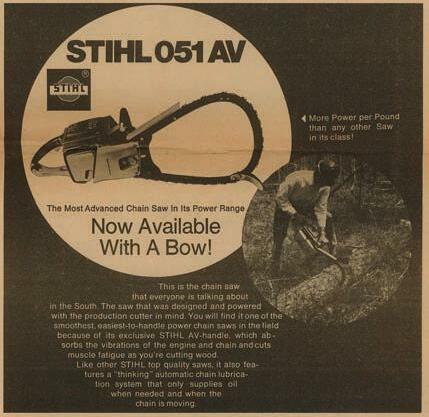
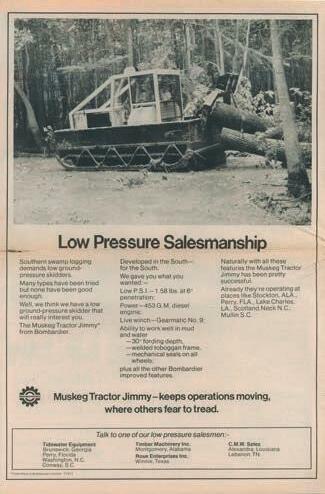
The sawmill chipping headrig emerged, blurring the distinction between pulpwood and sawtimber and giving birth to the term chip-n-saw. G-P, Kirby and Temple-Eastex began making plywood from southern pine.
Frank Hough Co. entered the wheeled skidder market with the S-7 Paylogger. (Hough was later acquired by International Harvester.)
In 1962 brothers Morrie and Ed Bartell bought legal rights to bankrupt Ramey Mfg. and built the Barko-Ramey KB for a season before dropping
l Temple Industries merges with Time, Inc., sole owner of Eastex, a TX-based pulp-paper subsidiary, creating Temple-Eastex.
l To remedy an FTC charge that it had created a monopoly in the softwood plywood business, G-P spins off new company in Louisiana Pacific.
Ken Ramey begins producing Viking loaders at Eufaula, AL.
Timberjack’s annual skidder sales top 2,000; company breaks ground for manufacturing complex at Tifton, GA, a project later stifled by recession, poor market.
l Foremost introduces 4-track articulated skidder, the 195A.
l FMC introduces 200CA and 200BG tracked skidders.
l Melroe debuts M-174 skidsteer FB.
l A hydraulic saw attachment for felling large hardwoods is developed by inventor Al Albright.
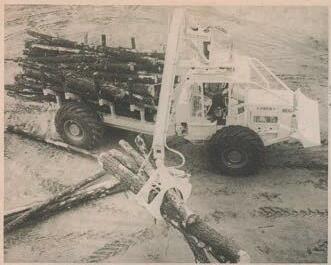
l Fleco Corp. offers four choices of grapples for Cat 518 skidder.
l Soderhamn debuts compact Go-Go wheeled skidder.
l Waldron introduces compact articulated wheeled pulpwood FB.
the Ramey name. Can-Car introduced a roadside pulpwood processor originally developed by MN logger Ray Hahn. The Ramey family launched another KB brand in Husky.
The Hy-Hoe KB was marketed by Hydraulic Machinery Co. John Deere, Taylor and Beloit introduced wheeled skidders—Beloit’s with a grapple option, an industry first. Clark re-entered the skidder market with Ranger line.
John Hood of MI founded Hood Equipment and eventually developed a line of forestry machines, including slashers, KB loaders, processors and more.
Union Camp Corp. paid $46 million for the assets of W.T. Smith Lumber Co. in AL. Weyerhaeuser purchased the MS sawmill and timberland properties of DeWeese Lumber Co.
Industry’s first production tree shear attachment, the Roanoke TF-1, was offered by Harrington Mfg. Co. Timberjack’s skidder sales hit 1,500 in a single year. ESCO offered its first skidder grapple. In 1966, the Ronen KB surfaced at developer Jim Sironen’s shop in Waycross, GA. Having bought Dwight Garrett’s Tree Farmer skidder line, Can-Car offered the Clipper, a boom-mounted shear fitted on C5 TF wheeled skidder.
NC’s Currie Mfg. marketed the Currie Cost Cutter, a gigantic stationary electric chain saw apparatus that complemented industry’s ongoing shortwood-to-longwood conversion process. Applications were on remote and/or mill woodyards.
Omark Industries acquired Prentice Hydraulics for $4.4 million. Soderhamn introduced its Pre-Hauler (forwarder). CAMECO introduced a wheeled skidder. G&S Mfg. marketed the Woodstick PTO-powered cable pulpwood loader. Franklin offered grapple option for skidders. Eaton Corp. bought Timberjack.
U.S. Plywood Corp. and Champion Papers merged.
American Pulpwood Assn., forerunner to FRA, launched the Harvesting Research Project with goal of “increasing efficiency of pulpwood harvesting and reducing unit costs.”
Increasingly, paper companies started up or added to company logging crews. Numerous new pulp/paper mills, sawmills and plywood plants were built from Texas to Virginia.
Morbark developed a portable Chiparvestor system to debark and chip long logs and soon thereafter offered industry’s first whole tree chipper.
Erv Drott rolled out the big Drott 40 tracked FB. Athey joined the wheeled skidder fray. J.I. Case acquired North American marketing rights to the Beloit skidder. Prentice debuted the portable Saw Buck slasher. Fulghum brought out the Quick Snip, a hydrostatic tri-wheeled tractor fitted with swiveling shear. Hy-Hoe marketed the 450 forwarder, its first mobile machine.
Omark offered the short-lived C-10 shortwood harvester; announced a new plant/office complex for Zebulon, NC that doubled as new headquarters for its Hydraulic Materials Handling Div.
Both Melroe and Universal offered skid-steer pulpwood harvesting models.
l DICO markets KB loader formally branded as Beloit.
l Timberjack debuts RW-30 wheeled treelength harvester; introduces a short-lived front-end loader.
l Stihl begins manufacturing chain saws at Virginia Beach, VA.

l Malcolm and Brenda Wood start up J.M. Wood Auction Co., Montgomery, AL.
l Whole tree chipper developments: new players include Bush Mfg., Trelan.
l Mead Corp. announces new pulp mill for Stevenson, AL.
l Husqvarna brings its pro saws to U.S. market.
l Loggin’ Times devotes its December issue to the legacy of eastern NC pulpwood producer T.R. Goodson and then current operations of five of his sons—Kenneth, Raymond, Allen, Harrell and Marvin.
l National Hydro-Ax is formed
in Owatonna, MN.
l Gafner opens small plant at Eufaula, AL.
l Rome Industries introduces a whole tree puller (tree extractor).
l Morbark offers tree shears.
l International Harvester brings out 3966 tracked FB.
l Pettibone Corp. buys Barko Hydraulics.
l Tidewater Equipment forms subsidiary Tidewater Mfg. to build Dixie Logger line of pulpwood harvesting/handling attachments, machines.
l Prentice comes out with 210 model KB.
l Parsons & Whittemore announces $256 million project, Alabama River Pulp, for Claiborne, AL.
l John Deere revisits KB market by offering seven models.
Massey-Ferguson marketed the 2200 Treever forwarder. Schield Bantam marketed a large log loader. Gafner Machine announced the 411 mini-skidder. Allis-Chalmers’ Buckmaster was introduced as a forklift-based pulpwood slasher. Can-Car offered a serrated shear identified as the Tree Feller. Franklin developed the Pack-A-Back forwarder line. Fleco offered a shear for Cat tractors. Florida innovator I.B. White developed a front-mounted, fold-up shear for crawlers, skidders.
West Virginia Pulp and Paper became Westvaco Corp. Weyerhaeuser paid $325 million for Dierks Forests.
Timberline marketed another IP/Busch-developed machine, the triwheeled TH-100 thinner-harvester. The skidder market attracted MasseyFerguson and Mountain Mfg. Another KB player arrived as Lucky Mfg. Ford touted the benefits of its 4410 Woods Tractor. Timberjack offered grapple options for part of its skidder line and introduced the Pulpjack pulpwood forwarder.
Ken Ramey, having relocated to Oregon, reintroduced the Ramey KB. Owatonna marketed a compact 4WD wheeled tractor for loading short pulpwood. Another KB player arrived in SAMCO.
Dunham introduced the Log Hog KB line to complement its rigid frame wheeled skidders. ESCO offered a 20 in. guillotine shear. M-R-S marketed a wheel skidder. Georgia’s Allen Hydraulics introduced a bunching shear.
Eaton produced its 10,000th Timberjack skidder; forged ahead with a $1 million research/development budget to improve existing product line and develop other attachment and advanced harvesters.
More KB developments: Copeland entered the market; Cascade Corp. acquired the Ramey line.
Copeland developed the Hydro-Slasher, a circle saw unit. Franklin offered a wheeled FB called the Little Feller.
Great Northern Paper and Nekoosa-Edwards Paper merged to become Great Northern Nekoosa. Caterpillar introduced its first wheeled skidder, the 518. Hy-Hoe, Husky formed an alliance and eventually merged. John Deere introduced two behind-the-cab KB loaders, the 3805 and 3807. Dunham Mfg. developed a shear for Log Hog wheeled tractors.
Brothers Ron and George Ramey produced another Ramey family loader, the short-lived EM-1400. Hawk Hydraulics offered a KB.
Boise Southern acquired 200,000 acres of timberland in LA and TX from Lutcher & Moore, a pioneer lumber company based in southeast TX.
FL logger Carl Sikes developed industry’s first gate delimber. Precision developed a whole tree chipper.
More than 12,000 attended the 11th SFPA Expo at Southeastern Fairgrounds, Atlanta.
Gar Scott left Timberjack to become a partner in TJ dealer Pioneer Machinery, then operating a single store in Columbia, SC.
Six years in development, Koehring Waterous of Canada introduced a behemoth shortwood harvester. Barko introduced the 250 and 160 model KBs.
l National Hydro-Ax offers its first wheeled FB, the hydrostatic (industry first) 311, and later a chain flail delimber, the LL-64, as an optional attachment for the 311.
l Allen feller/bundle buncher attachment hits the market.
l More loader news: Lynx and Grizzly brands appear.
l John Deere introduces 743 wheeled tree harvester.
l SFPA Expo outgrows New Orleans, makes one-time appearance in Dallas.
l Soderhamn exits forwarder market, leading its long-time forwarder evangelist Edgar Hodges to form his own company and introduce the Hanover Pre-Hauler.
l G-P acquires assets of Hudson Pulp & Paper.
l Clark Equipment’s Ranger 45
FB is withdrawn from market.
l Hydro-Ax introduces the 511 feller-buncher.
l Garrett-Weldco seeks Southern dealers for its 25-A skidder.
l Johnny Ward, founder of W&W Truck & Tractor, Moncks Corner, SC, is honored as Loggin’ Times’ inaugural Logging Equipment Salesman of the Year.
l G-P announces it will relocate HQ from Portland, OR to Atlanta, which it does four years later.
l Production of short pulpwood continues to decline.
l Tight petroleum supply causes many wood-using industries to invest heavily in wood-fired boilers, accelerating demand for fuelwood chips, sawdust, bark.
l G-P experiments with a biomass harvesting machine it calls Jaws 3.
l In outbidding Weyerhaeuser, IP acquires Bodcaw Co.’s linerboard mill in LA and more than
400,000 acres of timberland.
l Southwest Forest Industries purchases IP’s paper mill at Panama City, FL and 450,000 acres of timberland.
l SFPA Expo returns to New Orleans, packs the relatively new Super Dome.
l Line of shears is offered by Ronen Mfg. Co.
l Timberjack introduces the model 30 deck delimber to the South; acceptance poor.
l LT names Kit Avery of Timberjack of AL, Northport, Logging Equipment Salesman of the Year.
l Hartwell Hatton, founder of LT parent company Hatton-Brown Publishers, succumbs.
l Omark Industries acquires National Hydro-Ax.
l Morbark signs deal with Bell Equipment of South Africa to begin producing and marketing triwheeled Mor-Bell FB in U.S.
l CTR brings out line of bar/ chain slashers.
l Former WI logger Pat Crawford introduces the self-leveling Timbco tracked FB.
l Cat adds 227 tracked FB.
l International Harvester dealers offer 515 model wheeled FB.
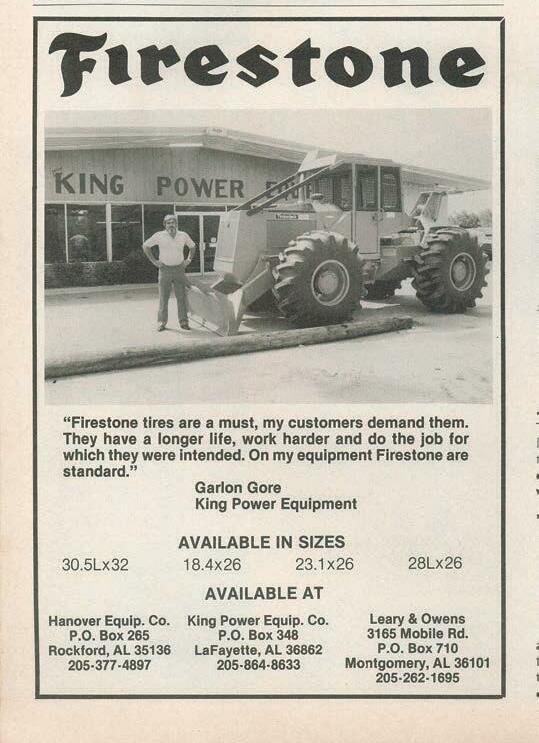
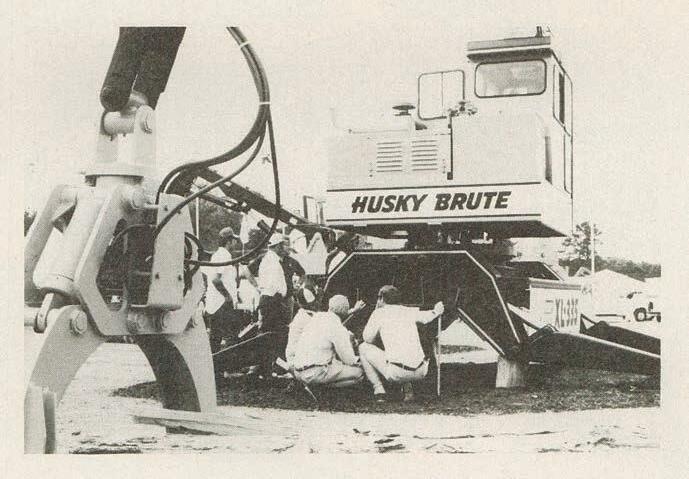
l LT names New Bern, NC’s Harry Bass of R.W. Moore Equipment, Logging Equipment Salesman of the Year.
l Loggin’ Times alters name to Southern Loggin’ Times and launches Southern Stumpin’ column.
l Oregon contractor Neil Peterson forms Peterson Pacific Corp. and a few years later builds model 4800 chain flail delimber.
l Gar Scott becomes sole owner of SC-based Pioneer Machinery.
l Timberjack introduces 520 clambunk wheeled skidder.
l SLT’s Logging Equipment Salesman of the Year is Harold Taylor of J.A. Riggs Tractor Co.,
offers 20 in. sawhead.
l Bell Equipment begins marketing tri-wheeled FB in U.S.
l SLT’s Logging Equipment Salesman of the Year is Cliff Fowler of Tidewater’s Conway, SC store.
l Bandit Industries is formed in Remus, MI.
l Stone Container purchases Continental Group’s containerboard division for $505 million.
l Omark buys assets of MARLOU, a MI maker of Blu Ox whole tree chippers.
l Dynamic Industries debuts Swinger 220, a compact FB.
l SLT selects Stan Smith of Emporia, VA as Logging Equipment Salesman of the Year.
l Peerless begins manufacturing KB loader.
l First OSB plants start up in South: G-P, Dudley, GA; MARTCO, Lemoyen, LA; LP, Corrigan, TX.
Koehring Canada brings out K2FF treelength feller-forwarder, a 35-ton capacity machine.
Boreal markets DD20 double
NC loggers form state associ-
l Champion International, St. Regis Paper merge.
l Cat introduces the 518 Harvester, its first wheeled FB.
l John Deere debuts 544-C FB.
l Timberjack is acquired by Sequoia Associates and senior TJ employees.
l Rome Industries tests two prototype KB models but never brings them to market.
l Larry Kitchen of McIntyre Equipment, Richmond, VA, is SLT’s Logging Equipment Salesman of the Year.
l Peterson Pacific markets chain flail delimber as companion unit for whole tree chippers.
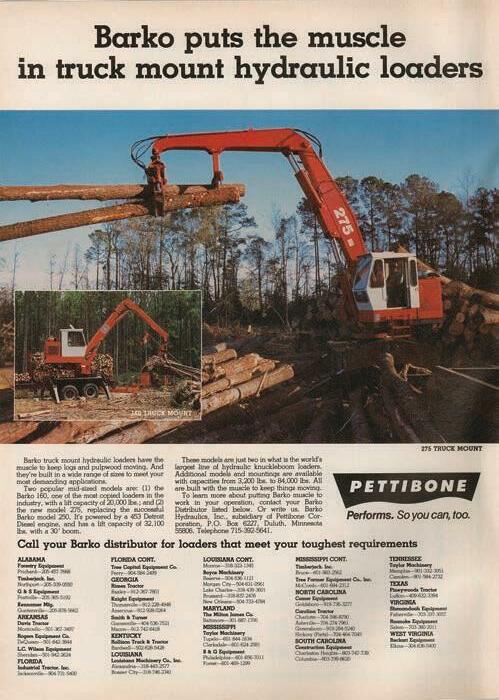
l Blount, Inc. pays $268 million for Omark Industries.
l Timberjack and Timbco reach an assembly/marketing agreement through which Timbco’s tracked FB is sold through TJ dealers as the Timberjack Timbco.
l Canadian sawhead manufacturers go South, gain lukewarm acceptance.
l Tidewater’s Cliff Fowler, Conway, SC, repeats as SLT’s Logging Equipment Salesman of the Year.
l Skidder grapple manufacturers include E-Z, Clark, Timberwolf, Tree Farmer, Rome, Young, Franklin, ESCO and Deere.
l Sawhead makers at SFPA Expo in Atlanta include Boreal, Koehring, Harricana and Dika.
l Barko’s first wheeled FB, the 775, becomes industry’s dominant sawhead carrier.
l Stone Container buys Champion’s brown paper operations for $426 million.
l South Africa’s Bell Equipment begins assembling its tri-wheeled FB in the U.S.
l Precision American Corp. buys assets of Husky Hydraulics and moves loader manufacturing to Leeds, AL from MN.
l LP purchases Kirby Forest Industries’ TX wood products plants and timberland for $315 million.
l Boise Cascade acquires Allied Paper’s plant at Jackson, AL.
l IP buys Hammermill Paper for $1.1 billion.
l CAMECO intros wheeled FB.
l Jim Spencer of Taylor Machinery Co., Tupelo, MS, is SLT’s Logging Equipment Salesman of the Year.
l Stone Container pays $787 million for Southwest Forest Industries.
l American Can Co. sells 142,000 acres of timberland in AL and MS to James River Corp. and Prudential Life Ins. Co. for $69 million.
l G-P buys 196,000 timbered acres in GA from Pratt Holdings of Australia.
l Mead Corp. and Temple Industries announce plans to dissolve Georgia Kraft Co., a joint venture with operations in Rome and Macon, GA.
l Gafner markets Tri-Trac FB.
l Morbark comes out with MCR tri-wheeled FB.
l Ronen markets 717 tracked FB.
l Another KB loader hits the
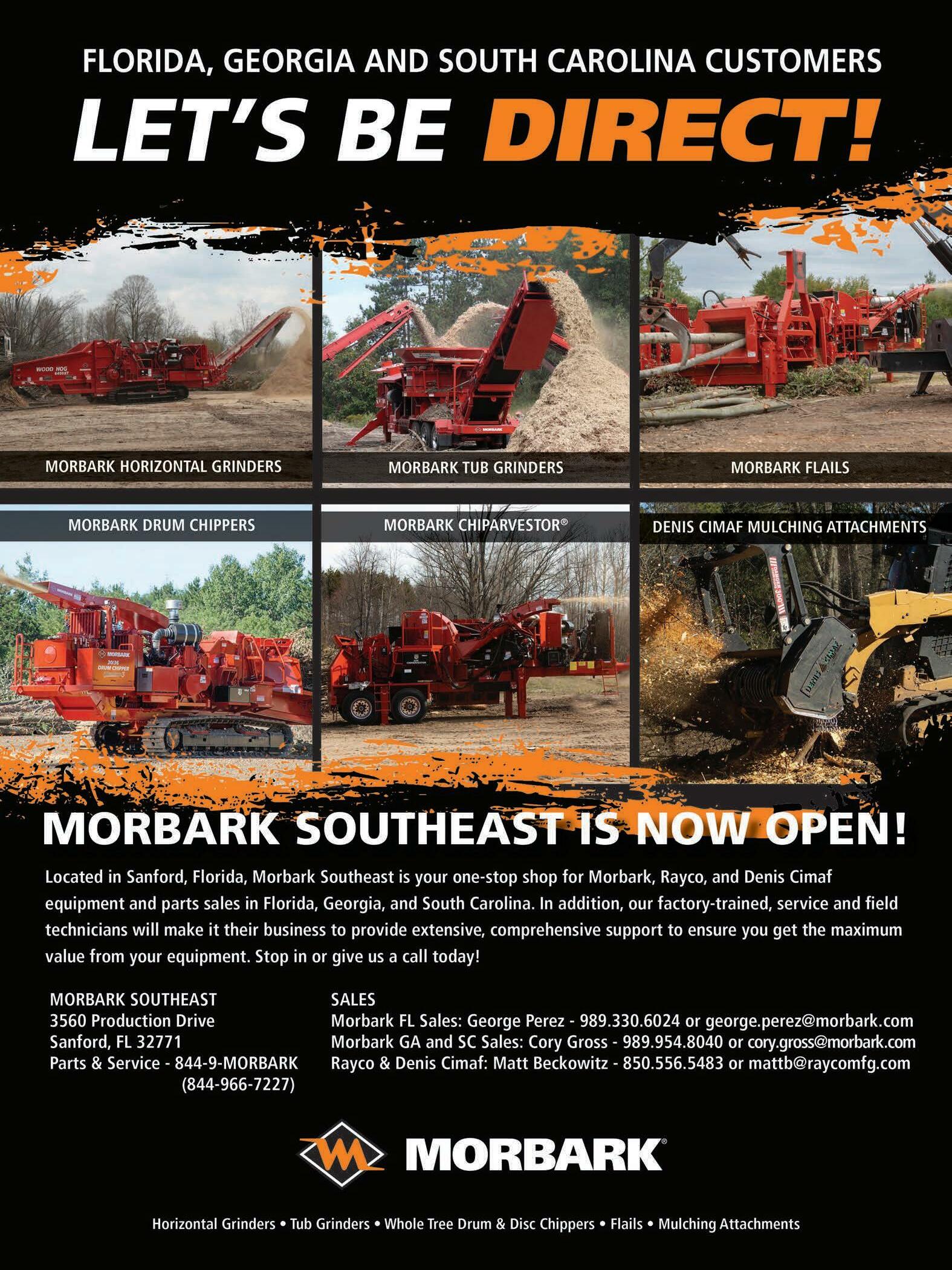
market in the Black Bear, offered by Minnesota Hydraulics for a very short period.
l ARDCO Industries develops clambunk skidder and 10-wheel treelength forwarder.
l CTR unveils 314 pull-through delimber. Designed for use with a KB loader, the delimber is the brainchild of NC logger Tommy Hamby.
l A dozen sawhead makers display products at SFPA expo in New Orleans: Bell, CTR, Denis, Dika, Franklin, Harricana, Hydro-Ax, Koehring, Risley, Ronen, Tenco and Timbco.
l VME offers seven new Ranger wheeled skidder models.
l Donnie McDaniel of King Power Equipment, Lafayette, AL, is SLT’s Logging Equipment Salesman of the Year.
l Robins Mfg. buys assets of AL forwarder maker Hanover Equipment. Later, Robins sells Hanover to Marathon LeTourneau Co.
l Sterlington, LA logger Sidney Stokes is awarded $1.52 million by a federal district court in Monroe, LA. It is the outcome of a lawsuit of Stokes against G-P, in
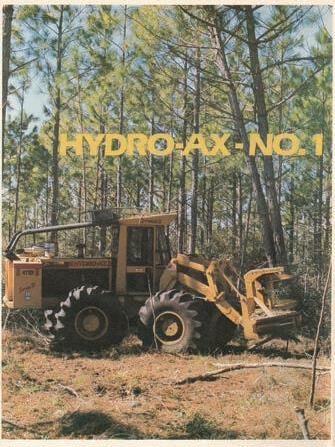
verbal chip contract. G-P appeals but the U.S. 5th Circuit Court upholds the award.
l Valmet acquires Gafner.
l Assets of Brunswick Pulp & Paper are bought by G-P for $665 million.
l Quadco Equipment is incorporated as a replacement parts business; develops quad tooth for sawheads and other products.

l Citing estimated lumber/plywood degrade losses at $2 million annually due to butt shatter, G-P bans shear-cut logs at its sawmills and plywood plants, thereby accelerating sawhead technology, acceptance and popularity.
l SLT’s Logging Equipment Salesman of the Year is Walter
Kinchen of Tidewater Equipment, Brunswick, GA.
l Barko acquires Bobcat skidsteer forestry equipment line of Melroe, begins offering compact 1080C FB.
l Log-A-Load for Kids emerges in SC as fund raiser for Children’s Miracle Network.
l Short pulpwood production continues to decline, gradually fades away.
l Tree Farmer ceases manufacturing forestry equipment.
l MS Loggers Assn. is formed.
l Valmet Gafner introduces Woodstar branded products.
l Timberjack acquires the construction equipment interests of Koehring-Waterous Ltd.; acquires Peerless; goes public.
l Chip mill construction remains active in South.
l Finnish conglomerate RaumaRepola OY purchases Timberjack, Koehring and Peerless for $120 million (US).
l Arsonists torch the logging equipment spread of NC’s Bobby Goodson, who would years later become TV’s Swamp Logger; loss put at $600,000.
l Bobby Huskey of Farm Equipment Co. of Asheville, NC, is SLT’s Logging Equipment Salesman of the Year.
l IP acquires Masonite Corp.
l Loggers in FL and GA form Southeastern Wood Producers Assn.
l Franklin Equipment’s Drake family buys assets of Tree Farmer Equipment Co. and resumes Tree Farmer skidder production.
l G-P purchases Great Northern Nekoosa Corp. for $3.7 billion in cash and assumption of $1.3 billion of debt. Later in year it sells various plants and 540,000 acres of timberland to Packaging Corp. of America.
l Valmet Gafner buys Ranger skidder line from VME Americas, changes name to Valmet Logging Americas.
l Rauma-Repola’s forest machine operations are reorganized as FMG Timberjack.
l Jim Spencer of Barton Equipment Co., Tupelo, MS, is again SLT’s Logging Equipment Salesman of the Year.
l An assembly/marketing agreement between Timberjack and
Timbco is dissolved after five years; TJ markets 600 series of tracked FBs.
l Willamette completes new pulp-paper mill at Bennettsville, SC.
l AR Timber Producers Assn. is formed.
l LA loggers create Louisiana Loggers Assn.
l Tigercat Industries takes root in Ontario, Can.

l SLT’s April issue includes a piece on sawhead technology and lists 19 manufacturers: Balder-
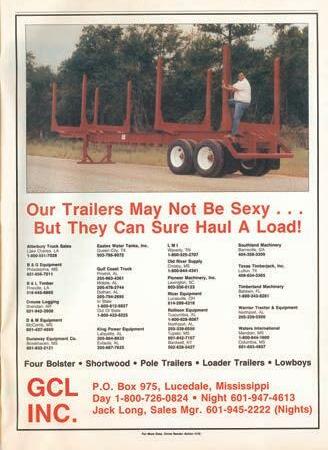
l SLT’s Logging Equipment Salesman of the Year is Thurman Taylor of Warrior Tractor Co., Northport, AL.
l Valmet brings out 503 triwheeled FB.
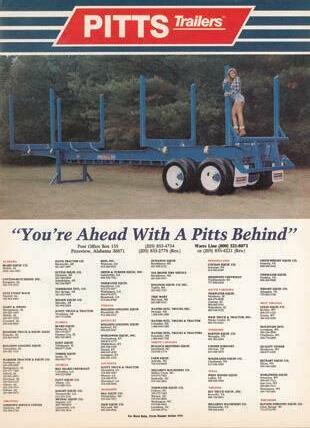
l Timberline Equipment unveils the ST 3530, a tracked delimber/processor.
l Parsons & Whittemore invests multi-millions in a pine pulp mill at its existing complex in Claiborne, AL. (No new greenfield pulp/paper project has been built in the U.S. since.)
l Tigercat introduces its first machine, the 720 wheeled FB.
l Forestry associations in AL and TX form respective logging councils.
l Eight state logging groups incorporate Southern Logging Coalition.
l Timberjack drops traditional orange color scheme after 30 years; goes to green, yellow and black.
l Federal law requires truck drivers to possess a Commercial
son, Barko, Bell, Canasaw, Denis, Dika, ESCO, EXCO, FORTEC, Franklin, Harricana, Hydro-Ax, Koehring, Nicola, Risley, Ronen, Timbco, Valmet and Wolverine. Later in the year another player appears in Univer/Saw.
l Ronen introduces tracked skidder for wet site applications.
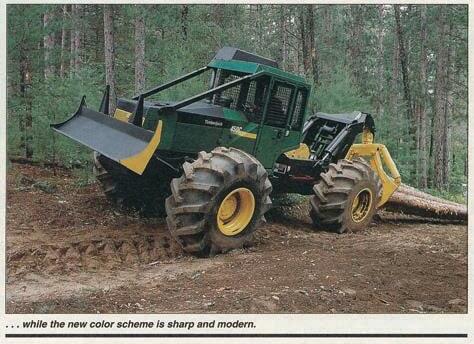
l Tree Farmer skidder production moves to VA from AL.
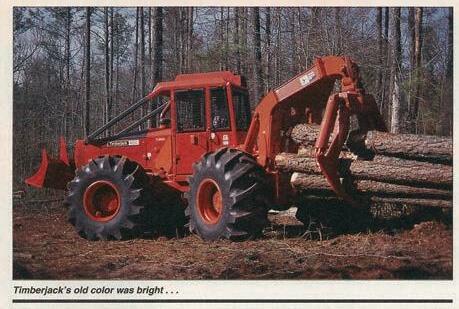
l SLT introduces Bulletin Board page in the August issue.
l Franklin rolls out tri-wheeled FB: Model 3000.
l M. M. Wright of VA is selected National Logger of the Year by American Pulpwood Assn. (APA).
l ESCO Corp. introduces two models of felling saws.
Driver’s License.
l Weyerhaeuser buys the GA assets of Proctor & Gamble’s Buckeye Cellulose Corp.
l Union Camp shuts down Rocky Creek Logging Co. subsidiary at Chapman, AL.
l SLT’s Logging Equipment Salesman of the Year is Norwood Houston of S&M Equipment, Elizabethtown, NC.
l Proctor & Gamble sells its pulp
mill and surrounding timberlands in north FL to a group of retired P&G employees.
l Timberjack brings out model 480 tracked grapple skidder for steep slope applications.
l About 2,500 MS loggers, employees and business associates rally at the state capital in Jackson to express concerns over taxation, DOT harassment, rural road use, etc.
l Connie and Robert Langley found Magnolia Trailers in MS.
l Valmet sells Ranger skidder line to Allied Systems of OR.
l Prentice KB loader sales exceed 40,000 since the brand’s inception in the late 1950s.
l Jerry Pender of Scott Construction Equipment, Monroe, LA, is SLT’s Logging Equipment Salesman of the Year.
l SLT adopts distinctive slogan: “The Southern Logger’s Best Friend.”
l American Loggers Council is formed.
l CTR develops a tri-wheeled FB dubbed The Stumper, but Blount, Inc. discontinues its production after buying CTR.
l Riley Mfg. begins producing pull-through delimbers and log trailers (later slashers) at Oglethorpe, GA.
l APA selects Buck Beach of MS as its National Outstanding Logger.
l Representing Beard Equipment in south MS, Cleve Altman is SLT’s Logging Equipment Salesman of the Year.
l Stroke delimbers and processor heads begin trickling into the South.
l FMG Timberjack begins manufacturing KB loaders (330 and 430); changes name to Timberjack Group.
l Shovel logging technique takes root on wet sites in parts of the South.
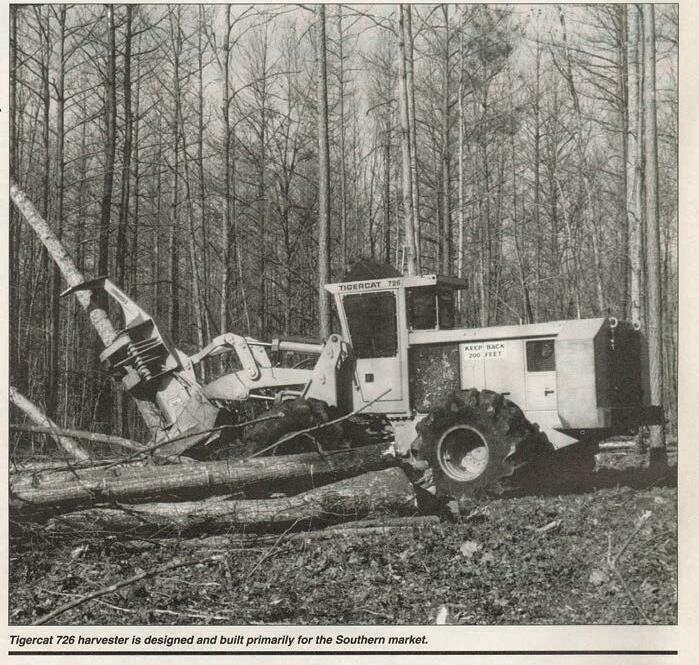
l Trencor, Inc. acquires Log Hog KB loader line.
l Timbco sells 500th T400 series tracked FB.

l Willamette buys Mead’s paper mill at Kingsport, TN.
l Valmet Logging Americas becomes Sisu Logging USA.
l David Sanders of Farrar Diesel, Meridian, MS, is SLT’s Logging Equipment Salesman of the Year.
l Koehring sells 3,000th sawhead.
l Louisiana Logging Council is formed within the Louisiana Forestry Assn.
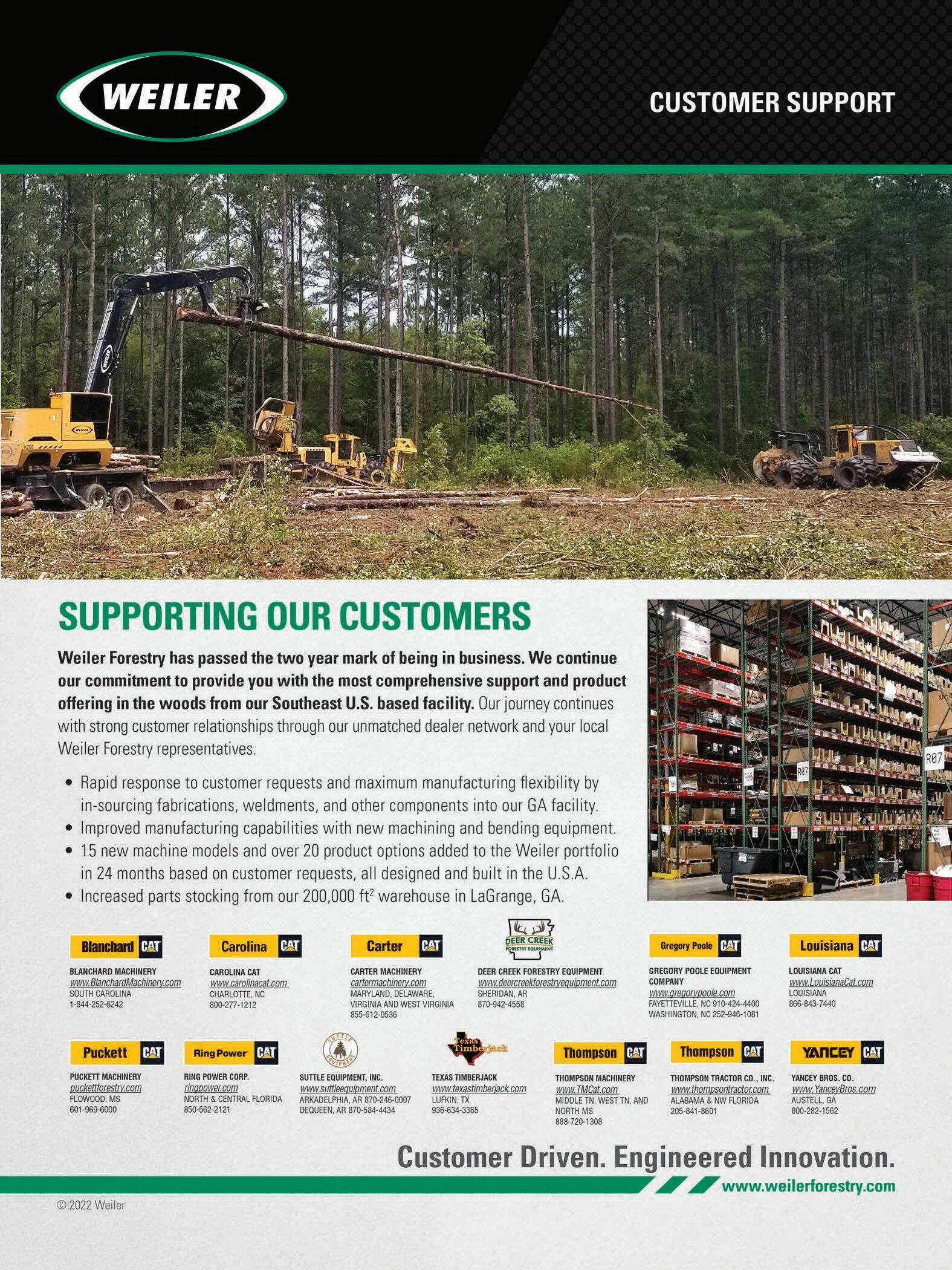
rights to Caterpillar.
l IP purchases Federal Paper Board for $ 3.5 billion.
l Virginia Loggers Council is established within the Virginia Forestry Assn.
l Iowa Tool markets three small KB loaders under the Eagle brand.
l Hudson Sales Corp., Hueytown, AL, promotes its slasher and pull-through delimber.
l Cutting Systems starts up at Union Grove, NC.
l Allied Systems pushes its 13model Ranger skidder line.
l Balderson introduces a stroke delimber.
l Timberjack markets tracked shovel logger, the 755SL.
l Four M Corp. and Stone Container acquire St. Joe Paper Co.’s paper mill at Port St. Joe, FL.
l Young Corp. debuts two new skidder grapples.
l SLT’s May issue contains 108 pages, topping the 88-pager in June 1989 as the largest to date.
l Timberjack purchases Hudson Sales Corp., an AL maker of slashers and pull-through delimbers.
l Tigercat introduces its first wheeled skidder, the hydrostatic 630.
l Franklin enters the KB market with the KBL-35.
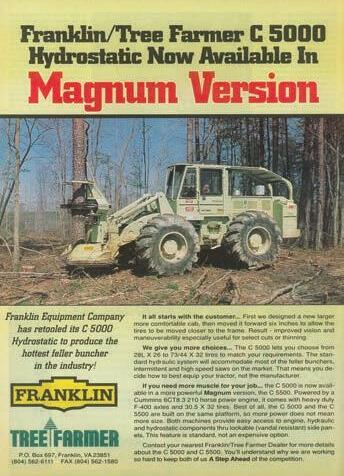
l SLT picks Tidewater’s Donald Knight, Jr., Thomasville, GA, as Logging Equipment Salesman of the Year.
l Hydro-Ax comes out with a triwheeled FB, the 321.
l Allied Systems Co. acquires Hanover forwarder line from Marathon LeTourneau Co.
l SC’s Tracy Gunter is named National Outstanding Logger by APA.
l Caterpillar begins construction of a skidder assembly plant in LaGrange, GA.
l SLT publishes 25th Anniversary Issue (October), its largest ever at 152 pages. Content includes a tribute to ‘25 Men Who’ve Made A Difference’ in the industry. Honorees include Buck Beach, Allen Bedell, Paul Bell, Bill Boyce, Mal Crawford, Roger Drake, Tracy Gunter, Tommy Hamby, Ralph Metcalf, Jimmy Mitchell, Tom Morgan, Jr., Richard Reeves, Matt Rigoni, Al Rollison, Ken Rolston, Alvin Schilling, Gar Scott, Carl Sikes, Gord Sims, Bill Stuart, Johnny Ward, Joe Watkins, Joe Wood, M.M. Wright, and Joe Young. (The SLT staff secretly included Co-Publisher DK Knight just before the issue went to press.)
l Tigercat brings out the 860S shovel logger and its first KB, the 230.
l Sisu Logging USA begins marketing 603 tri-wheeled FB; Sisu is purchased by Partek.
l G-P forms a new entity, The Timber Co., and places its 4.7 million acres of timberland therein.
l Benny Jones of Puckett Machinery, Meridian, MS, gets SLT’s nod for Logging Equipment Salesman of the Year.
l MS logger Eric Chambers begins making and selling the Chambers Delimbinator chain flail delimber.
l Huber Engineered Woods opens OSB plant at Spring City, TN.
l GA logger Ken Murray develops a portable platform weigh scale marketed by Maxi-Load Scale Systems.
l Pioneer Machinery acquires S&M Equipment Co., giving it a total of 25 locations in multiple Southeastern states.
l Timbco introduces the TF815, a 16-ton capacity wheeled forwarder.
l Ronen Mfg. Inc. develops a pull-through delimber.
l Timberjack markets 850 and 950 tracked FBs, introduces 530 and 635 (tracked) KB loaders.
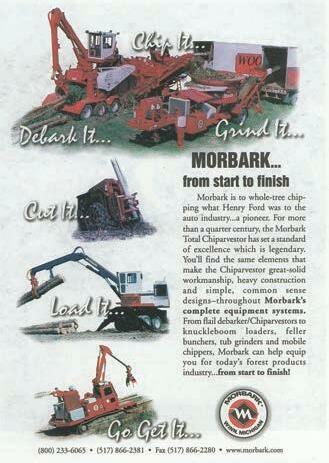
l Texan Joe Cherry is selected as FRA’s National Outstanding Logger.
l Precision Husky Corp. acquires the Recycling Equipment Div. of The Toro Co.
l Fabtek markets FT-133 tracked harvester.

l For $6.6 billion, IP acquires assets of Union Camp Corp.
l Caterpillar enters CTL arena with three harvesters, two forwarders and four harvesting heads.
l Kimberly Clark sells its remaining timberland, 460,000 acres, in AL, MS and TN to Joshua Management LLC for approximately $400 million.
l Tigercat reveals 620 skidder.
l Caterpillar introduces 539 KB loader.
l Blount International reaches a $1.35 billion deal to sell to Lehman Brothers Merchant Banking Partners.
l Wood Supply Research Institute is formed as a coalition of wood fiber consumers, suppliers and associations.
l Waratah of New Zealand and Koehring Waterous of Canada merge, creating Waratah Forestry Attachments.
l Riley Mfg. introduces skidder grapple.
l American Pulpwood Assn. changes name to Forest Resources Assn.; selects GA’s Travis Reed as National Outstanding Logger.
l John Deere acquires Timberjack Group from Finnish company Rauma-Repola for $600 million.
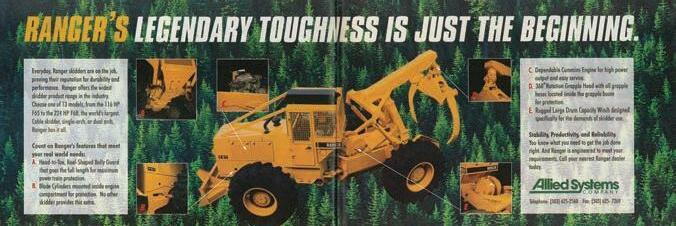
l Timbco’s tracked equipment line is acquired by Partek Forest.
l Liebherr enters KB loader market with A902TM.
l Smurfit-Stone Container buys St. Laurent Paperboard for $1 billion.
l Denharco introduces the 4000 series of delimbers (four models).
l Tigercat purchases Hemek, a Swedish CTL machine manufacturer.
l IP discloses plans to shut paper mills in Mobile, AL and Camden, AR; acquires Champion International’s assets for $7.3 billion.
l Products shown at the Richmond Expo include Timbco’s 8wheel drive clambunk machine, Tigercat’s 635 6-wheel drive clambunk skidder, Franklin’s 4200S2 wheeled FB, Riley’s Southern Stroke delimber and pull-through delimbers and slashers from Waratah and CSI.
l The forest products industry raises $2.75 million for the Children’s Miracle Network through Log-A-Load for Kids.
l Caterpillar offers 517 tracked skidder.
l G-P buys North American assets of Fort James Corp. for $11 billion.
l Riley Mfg. reveals HydraGate multi-stem delimber.
l Plum Creek purchases The Timber Co. from G-P for $4 billion.
l A federal court jury awards Jesup, GA logger Grant Lewis $1.2 million in a civil action in which Lewis contended that local pulp manufacturer Rayonier broke two contracts in the ’90s that cost him more than $600,000.
l Pioneer Machinery, the Southeast’s largest forestry equipment dealer, and two smaller affiliated entities, are acquired by Caterpillar for an undisclosed sum. Pioneer essentially becomes a Cat dealer. Cat, in turn, offers stock to its dealers impacted by
the Pioneer transaction.
l Caterpillar purchases Timberking tracked FB line from Canadian manufacturer Risley Equipment, expands the brand to other products.
l John Deere begins buying out Timberjack dealers.
l Franklin launches a skidder remanufacturing program.
l Blount rolls out 70 series Hydro-Ax FBs, Prentice 384 KB and formally introduces the recently acquired Fabtek CTL line.
l Tigercat markets its first zero tail swing tracked FB, the 822.
l Joe Wood, 61, well-known icon of Barko Hydraulics, is killed in a farm tractor mishap at his northwest FL farm.
l Mead Corp. and Westvaco merge in an $8 billion transaction and become MeadWestvaco Corp.
l Former TX logger Danny Dructor becomes leader of the American Loggers Council.
l Timbco founder Pat Crawford, 77, forms TimberPro and begins making large forwarders and harvesters.
l Tigercat markets 250 KB, 718 wheeled FB, M760 mulcher.
l Franklin extends remanufacturing program to FBs.
l Weyerhaeuser acquires Willamette Industries in a $6.2 billion hostile takeover.
l Morbark reintroduces Wolverine 6300XL tri-wheeled FB.
l Blount introduces a skidder, its first ever, dual branded as Prentice 490 and CTR 950.
l IP’s wood procurement practices come under scrutiny by SC state officials; lawsuits are filed.
l VA Loggers Assn. is formed.
l Numerous logging operations in East Texas are temporarily halted as federal forces search several counties for debris of the Columbia space shuttle, which disintegrated over the area on February 1 while returning to Earth.
l Blount and Cat reach a manufacturing/supply/marketing agreement to expand the scope of purpose-built forestry equipment available from the respective companies. Involved are the brands Hydro-Ax, Prentice, Fabtek and Timberking.
l Usher Land & Timber, Chiefland, FL, is FRA’s National Outstanding Logger.
l Tigercat celebrates production of its 4,000th forestry ma-
chine, a 240B loader.
l Komatsu acquires Partek Forest.
l Log Max of Sweden acquires Cat’s CTL product line.
l Blount introduces 1000 series of Prentice tracked FBs.
l A small number of Southern loggers adopt two shift operations with mixed results; most retreat after a few weeks or months.
l Tigercat produces its 5,000th
machine, a 720D FB.
l Southern Loggers Cooperative is formed in LA as brainchild of logger Travis Taylor.
l Barko ceases production of its 160 series KB loader, having made it since 1970. (Barko made almost 9,000 160, 160A and 160D models across 34 years.)
l Privately owned Koch Industries acquires G-P.
l SLT begins serial reproduc-
tion of the book Red Hills and Cotton.
l IP announces plans to sell its 6.8 million acres of U.S. timberland, almost 6 million of which are located in the South.
l Mid-Star Timber Harvesting, Toxey, AL, is FRA’s National Outstanding Logger.

l Caterpillar drops the Timberking brand of purpose-built forestry equipment sold by its dealers.
l FRA selects SC’s Bishop Forest Products as its National Outstanding Logger.
l Barko markets model 950 forestry mulcher.
l Blount drops Hydro-Ax and Fabtek brands; Prentice brand becomes universal for Blount’s machine lineup.
l Tigercat unveils 610 skidder.
l McClendon Trailers starts up in Phenix City, AL.
l CSI introduces FDT-6000 flail/pull-through delimber.
l Ideal Logging, Edgemoor, SC, is selected as FRA’s National Outstanding Logger.
l SLT begins serialization of the book, Chainsaws: A History.
l Canada-based West Fraser Timber Co. acquires 13 sawmills in the South from IP.
l Astec Industries buys Peterson, Inc., an Oregon manufacturer of whole tree chippers, delimbers and horizontal grinders.
l Deere brings out H-Series skidders.
l Pitts Enterpises buys Dorsey Trailer, Elba, AL.
l Tigercat markets model 234 KB loader.
l Caterpillar acquires the Forestry Div. (Prentice and CTR brands) of Blount International (no terms were disclosed); and agrees to sell certain assets of Pioneer Machinery to six of its dealers.
l LP opens $230 million OSB plant at Thomasville, AL.
l IP sells Chapman, AL sawmill/plywood plant complex to Chapman Forest Products.
l Timber Harvesting magazine selects Parnell, Inc., Maplesville, AL as Logging Business of the Year.
l Franklin Equipment, owner of Franklin and Tree Farmer brands, shuts down, files for bankruptcy.
l SLT begins serialization of the book, Nameless Texas Towns.
l Tigercat introduces the 630D skidder.
l Castleberry Logging, Inc., Castleberry, AL, is named Timber Harvesting magazine’s Logging Business of the Year.
l Dynamic Mfg. Corp. debuts CH585 whole tree chipper.
l Selma, AL’s Dixie Pellets, once considered the world’s largest pellet plant, files for bankruptcy.
l Swamp Loggers, featuring
NC logging firm Goodson All Terrain Logging, debuts on TV’s Discovery Channel.
l G-P buys Alabama River Pulp’s pulp-paper complex (AL) from Parsons & Whittemore and two OSB plants in SC from Grant Forest Products.
l Tigercat introduces LS855C shovel logger.
l RWE Innogy announces a large pellet plant to operate as Georgia BioMass in Waycross.
l JD dealer Flint Equipment acquires GA JD dealer METRAC (five locations).
l Zilkha Biomass Energy of Texas purchases the plant of bankrupt Dixie Pellets, Selma, AL.
l Dynamic brings out its first horizontal grinder, the 5240.
l Vermeer markets its first whole tree chipper, the WC2300.
l JD markets K series wheeled FB models.
l Enviva builds new pellet plant in Ahoskie, NC.
l Rock Tenn acquires Stone Container Corp. for $3.5 billion.
l Peterson introduces trackmounted 4310 drum chipper.
l Dominion Virginia Power announces it will convert three coal burning power plants to biomass by 2013.
l River Ridge Equipment LLC emerges in AR as a rebuild specialist for JD skidders.
l Terex Corp. acquires Woodsman LLC and its line of chippers/grinders.
l Cat reveals new wheeled FB models for Cat, Prentice.
l German Pellets reveals plans for new pellet plant at Woodville, TX.
l Tigercat introduces tracked 880 carrier.
l Barko acquires Dynamic line of whole tree chippers.
l SLT begins serialization of the book Sawmilling With Paw
l Rentech purchases Fulghum Fibres’ 32 chip mills for $110 million.
l Komatsu Forest AB acquires Log Max AB and Log Max, Inc.
l G-P acquires Temple Inland’s building products business from IP for $750 million.
l Drax announces it will build new pellet plants in both MS and LA.
l Canfor buys Scotch Gulf Lumber, operator of sawmills in Mobile, Fulton and Jackson, AL.
l Barko introduces 240 track harvester.
l Almost 3,000 participate in Mid-Atlantic Logging & Biomass Expo in eastern NC.
l Interfor purchases Tolleson Ilim sawmills at Preston and Perry, GA.
l Travis Lumber sells Mansfield, AR sawmill to West Fraser.
l SLT publishes 500th issue in May.
l West Fraser acquires Bibler Brothers Lumber sawmill at Russellville, AR.
l GA’s Yancey Bros., the nation’s oldest Caterpillar dealer, celebrates 100 years.
l Caterpillar releases D series wheeled skidders.
l SLT devotes editorial content to ladies in logging with August issue.
l Canfor buys two more southern pine sawmills in GA: Balfour at Thomasville and Beadles at Moultrie.
l Highland Pellets tells of new $130 million pellet plant for Pine Bluff, AR.
l Enviva announces new pellet plants for Richmond and Samson counties in NC; tells of plans to acquire Green Circle Bio Energy’s pellet plant at Cottondale, FL.
l Southern Lumber Co. sells Hermanville, MS sawmill to Canfor.
l Logger Tommy Burch is inducted into the Texas Forestry Hall of Fame.
l Portucel Group reveals plans for $110 million pellet plant at Greenwood, SC.
l Martco says it will build $235 million OSB plant at Corrigan, TX.
l Rock Tenn Co. and MeadWestvaco merge to form WestRock.
l Deere introduces L series wheel skidders and FBs; L series tracked FBs and harvesters.
l Tigercast releases small skidder in model 610E.
l R Squared Solutions reveals pull-through delimber.
l Terex acquires Continental Biomass Industries.
l Interfor buys Monticello, AR sawmill owned by The Price Companies.
l Del Fab brings back a triwheeled FB to market.
l Weyerhaeuser announces $190 sawmill for Dierks, AR.
l Anthony Forest Products of AR sells Southern wood products
manufacturing assets to Canfor.
l Biewer Lumber reveals plans for $85 million sawmill at Newton, MS.
l Hood industries purchases sawmills at Bogalusa, LA and Silver Creek, MS from Joe N. Miles & Sons.
l Plum Creek Timber merges with Weyerhaeuser, creating a REIT with more than 13 million acres of timberland.
l TEAM Safe Trucking is formed to help elevate the professional performance of forest products transportation.
l Stellex Capital Management acquires Morbark Industries.
l IP buys Weyerhaeuser’s five cellulosic fibers pulp mills for $2.2 billion.
l Quadco Equipment buys Southstar line of processing and felling heads.
l Southern Loggers Cooperative grows to 27 fuel stations in seven states.
l New softwood sawmill by Two Rivers Lumber is announced for Demopolis, AL.
l Kronospan plans $320 additional investment for its wood products and resin facilities at Oxford, AL.
l Influential and eminent forestry leader Allen Bedell is inducted into the Arkansas Farm Bureau’s Agriculture Hall of Fame.
l Winston Plywood & Veneer opens plant at Louisville, MS.
l Drax Biomass acquires former Louisiana Pellets plant at Urania, LA.
l Tidewater Equipment marks 70th anniversary with Demo Day event in south GA.
l Tigercat celebrates 25th anniversary.
l West Fraser buys seven lumber and millwork operations owned by the Gilman Companies in Georgia and Florida.
l G-P announces $100 million sawmill at Talladega, AL.
l M.M. Wright, Inc., Gasburg, VA, is selected Logging Business of the Year by Timber Harvesting.
l Tigercat introduces 480B track mulcher and 4061 mulching head.
l Potlatch Corp. and Deltic Timber Corp. merge into a REIT called PotlatchDeltic Corp.
l Enviva tells of plans to purchase Portucel Group’s pellet plant at Greenwood, SC.
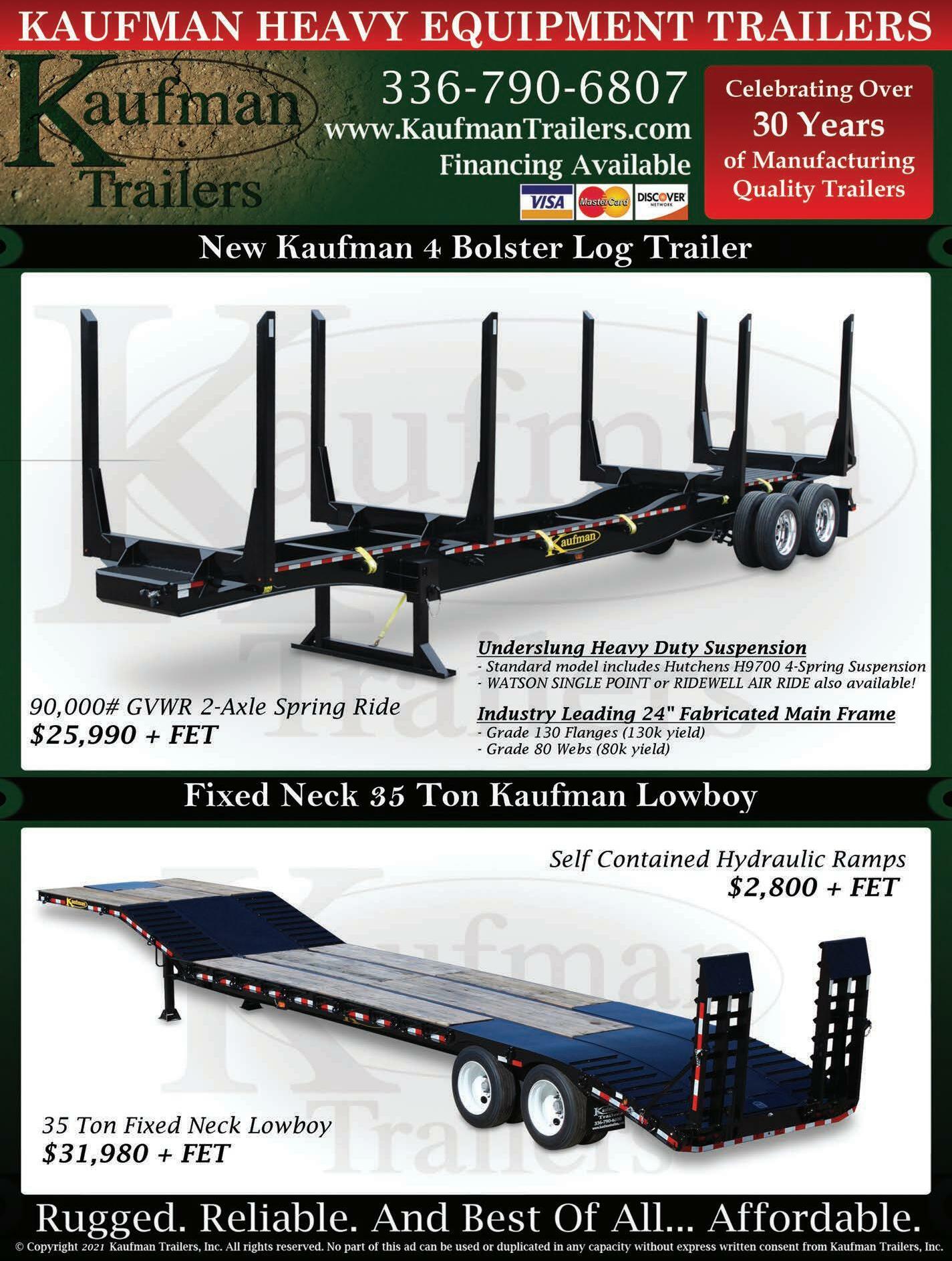
l Komatsu acquires attachment businesses of Quadco, Southstar; introduces XT-5 tracked FBs.
l WestRock buys KapStone for $4.9 billion.
l With a high bid in bankruptcy court, The Price Companies acquires chip mill interests of Fulghum Fibres.
l New high capacity softwood sawmills announced: Rex Lumber, Troy, AL; Hunt Forest Products/Tolko Industries, Urania, LA; G-P, Warrenton and Albany, GA; Angelina Forest Products,
Lufkin, TX.
l Tigercat introduces 602 cable skidder.
l Vicksburg Forest Products begins hardwood-to-softwood conversion process of former Vicksburg, MS sawmill once owned by Anderson-Tully.
l Caterpillar and Weiler Forestry sign a preliminary agreement in which Cat would sell its line of purpose-built forestry machines and related facilities to Weiler.
l Conifex Timber buys soft-

wood sawmills in Cross City, FL and Glenwood, AR.
l Fryfogle Mfg. starts building trailers in Lucedale, MS.
l Southern Loggers Cooperative opens 31st fuel station; now operates in eight states.
l Timber Harvesting magazine picks Log Creek Timber, Johnston, SC, as its Logging Business of the Year.
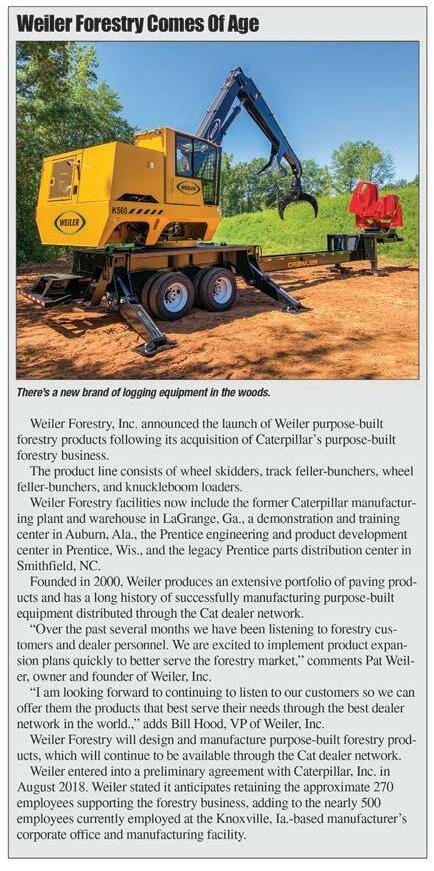
l More sawmill news: Canfor buys Elliott Sawmilling Co., Estill, SC; Tolko teams with Southeastern Timber Products at
Ackerman, MS; Westervelt plans new facility at Thomasville, AL.
l The Wood Supply Research Institute (WSRI) is dissolved after 20 years.
l Barko reenters the wheeled FB market with introduction of 300 HP 830B.
l Alamo Group completes acquisition of Morbark, LLC.
l Tigercat markets 1175 CTL wheeled harvester.
l Deere markets FS50/FR50 felling heads.
l Weiler completes acquisition of Cat’s purpose-built forestry machines and support facilities for undisclosed sum; rolls out B457, B458 tracked FBs; ceases offering the Prentice brand of log loader.
l Waratah releases a large felling head in FL100, a small harvesting/processing head in H212, and large harvesting head in H415HD.
l FRA selects Tapscott Brothers Logging of VA as National Logger of the Year.
l Tigercat introduces 568 harvesting head, offers compact 602 grapple skidder.
l Enviva purchases GA Biomass pellet plant at Waycross from Innogy SE for $175 million.
l Timber Harvesting names LA’s McManus Timber Co. Logging Business of the Year.

l Remote controlled track slasher is introduced by Spruce Creek Mechanical.
l Tigercat introduces H series wheeled skidders.
l West Fraser pays $3.1 billion for Norboard, the world’s largest OSB producer (15 plants).
l Jasper Lumber and Tolko Industries announce joint venture to expand Jasper’s existing pine lumber output at Jasper, AL (from 70MMBF per year to 200MMBF per year)
l Mission Forest Products announces $160 pine sawmill at Corinth, MS.
l Forestry Mutual Ins. Co. celebrates 50th anniversary.
l Weyerhaeuser plans to invest $157 million to modernize its pine sawmill at Holden, LA.
l Interfor buys three pine sawmills in the South from G-P: Bay Springs, MS; DeQuincy, LA; and Fayette, AL.
l Canfor announces $160 pine sawmill for DeRidder, LA.
l Roseburg Forest Products tells of plans to erect a high production pine sawmill at Weldon, NC.
l The Forest Resources Assn. selects Gray Logging, Madison, FL, as its National Outstanding Logger.
l Work begins on $240 million pine sawmill near Taylor, LA. It is a joint venture between Hunt Forest Products and Tolko Industries.
l Biewer Lumber begins construction of second pine sawmill in MS, this one at Winona.
l MARTCO reveals plans for a second OSB plant near its existing OSB plant at Corrigan, TX.
l New pine sawmill in TX: G-P tells of $120 investment at Pineland.
l West Fraser pays $300 million for Angelina Forest Products’ pine sawmill at Lufkin, TX.
l G-P sells Allendale, SC OSB plant to West Fraser for $280 M.
l Idaho Forest Group announces $120 million pine sawmill at Lumberton, MS.
l Ponsse builds its 16,000th forest machine at Vierema, Finland.
l Tigercat offers 760B mulcher and companion 4061-30 mulching head.
l WestRock sells its pine sawmill at Summerville, SC to Interfor for $59 million.
l John Deere markets six-wheel
768L-11 bogie skidder.
2022 (through September 15)
l Drax announces three satellite pellet plants in Arkansas projected to eventually produce a combined 120,000 tons of pellets per year.
l Resolute Forest Products shuts down paper mill at Calhoun, TN.
l Tigercat rolls out new products: swing yarder, swing boom grapple skidder and TCI forestry bulldozer.
l Bandit Industries acquires The Trelan Co. and continues production at Trelan’s Remus, MI plant.
l Enviva opens new pellet plant at Lucedale, MS; begins construction of another pellet plant at Epes, AL; tells of expansion at Ahoskie, NC plant.
l WestRock shuts down Panama City, FL pulp-paper mill, eliminating market for 2.75 million tons of pulpwood annually.
l Another Enviva pellet plant announced; this one at Bond, MS.
l Fourth generation logger Bobby Goodson (TV’s Swamp Loggers) leaves logging behind, citing rising costs, labor issues,
slow mill response.
l An affiliate of Claw Forestry Services announces a $200 pine sawmill project near Gloster, MS.
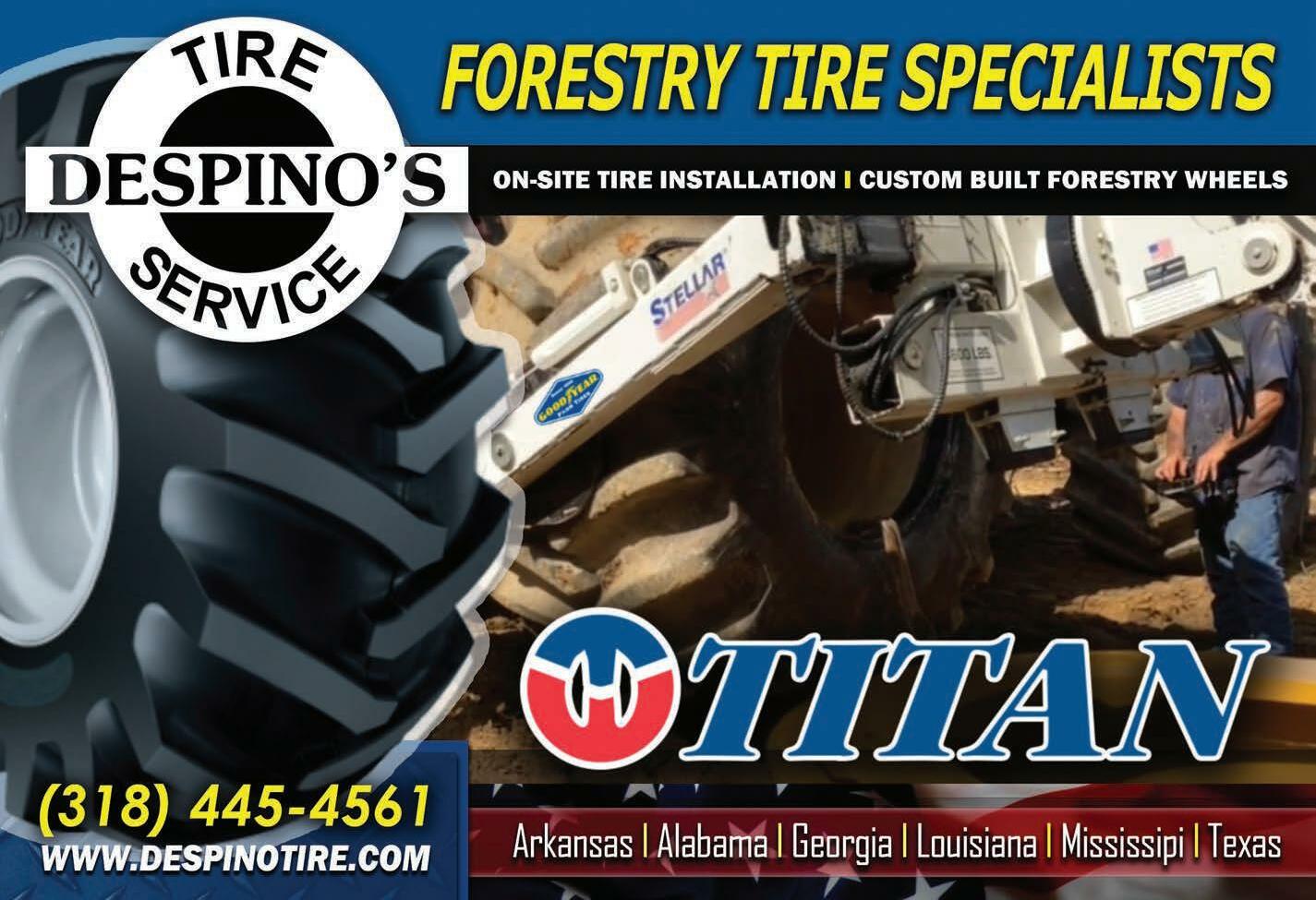
l PotlatchDeltic plans to invest $131 million to upgrade/expand its pine sawmill at Waldo, AR. Output will go to 275MMBF per year from 190MMBF.
l Domtar offers $2.7 billion for assets of Resolute Forest Products.
l Boise Cascade says it is buying Coastal Plywood’s plywood plant at Havana, FL and Coastal Forest Resources’ plywood and sawmill complex at Chapman, AL.
l Southeastern Timber Products reveals it will invest $150 million to double production at its sawmill at Ackerman, MS.
l Canada-based Teal Jones Group announces $110 million sawmill investment at Plain Dealing, LA.
l Canfor is erecting a new $210 million sawmill in Mobile County, AL. Once up and running, the new mill will replace Canfor’s existing sawmill at Mobile.
l Finnish manufacturer Ponsse announces it will offer a diesel/electric forwarder, the EV1. SLT
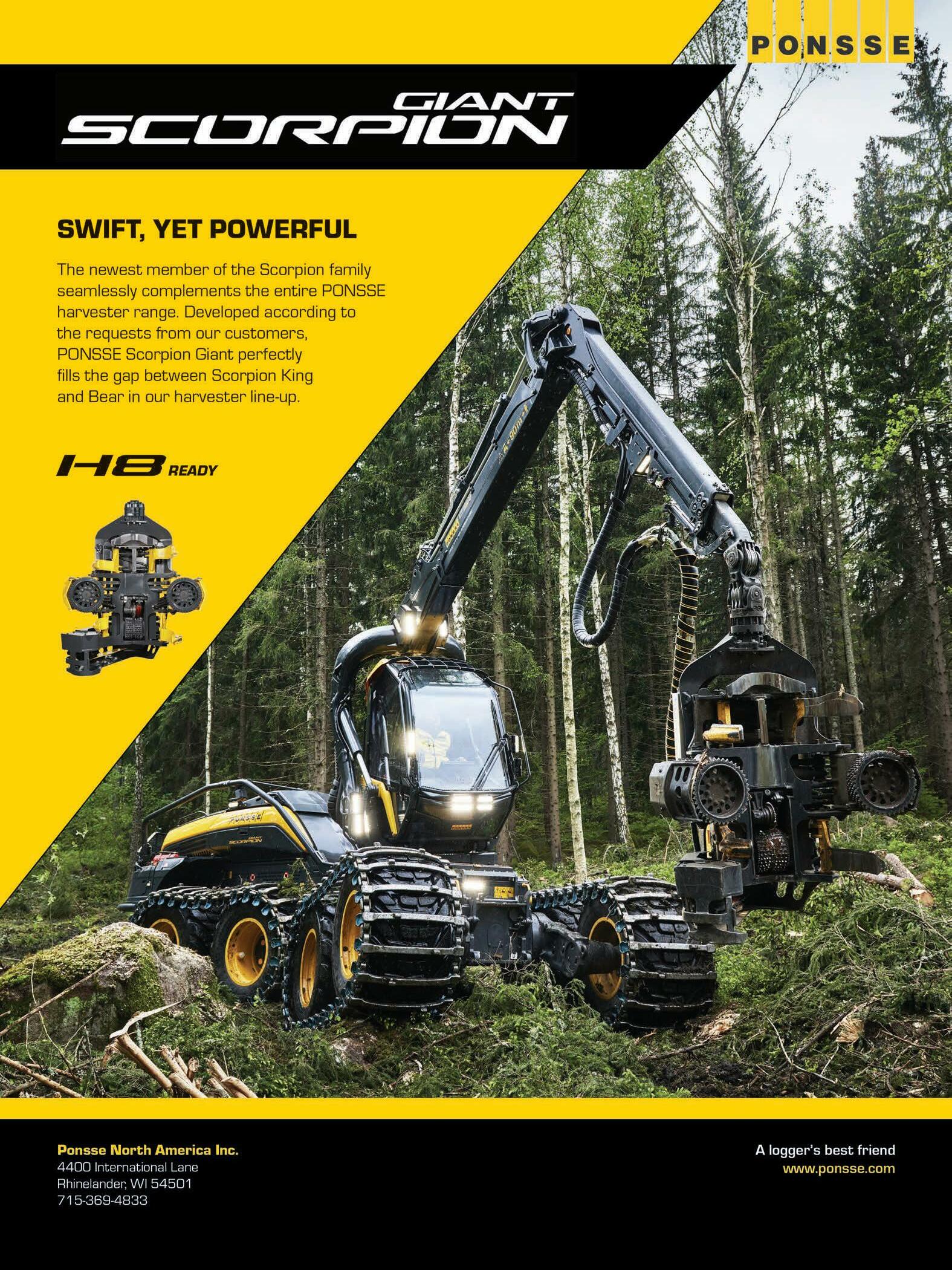
■ Readers share their stories in letters to the editor.
We asked y’all for reader participation, and you sure as heck delivered. In fact you delivered so much that unfortunately we just don’t have room to include everything we received from everybody who responded, but we think you’ll enjoy reading what we have been able to fit in.
■ Let’s get right to the subject at hand. My first encounter with SLT was in the mid ’70s when my dad, who was a logger, would settle on Fridays at the office of the wood dealer he did business with. There would always be the latest issue for you to browse as they reconciled the week’s production. I always admired the latest equipment and techniques featured in the articles, and was always blown away by the production numbers of the crews as my dad was just a small family business that produced two or three loads a day.
In 1992 with the help of my dad I started my own logging business and a subscription to SLT soon followed. Within weeks as I was browsing in the used equipment section I came across an ad for B&G Equipment that had a CTR directional felling head and within a few short days a deal was made. Delivery was worked out as a backhaul to North Carolina, I just had to go to CTR’s manufacturing facility to pick it up.
With much pride my business was featured in the April 2007 issue of SLT. Now we are in 2022 and how things have changed. I am still logging but with much less emphasis on production. Thankfully I am still running some of the same equipment that was mentioned in the interview.
I still look forward to each new issue, and I still browse the used equipment. The Bulletin Board is a favorite, as I occasionally use one of the jokes at church to lighten the mood. The industry news is also appreciated.
Thank you for all the work that your team puts into the publication. In closing I would like to say that one of the most memorable things that I have seen or read in SLT was an advertisement featuring a John Deere skidder with dual 44 in. tires all around in what looked to be about two feet of mud. That was before we learned the importance of BMPs. Lol!
Sincerely, Danny Cole
■ My father, Earl Towe, quit school in the third grade to work for my grandfather, Iver Towe, as the off-bearer in the sawmill. Back then they carried the sawmill to the woods and sawed lumber on site. Granddaddy logged and farmed as well. In 1951, when dad was 22, he married my mom, Ann, and started logging full time with Earl H. Towe Logging. All he had to log with was a two-man Mercury chain saw. Momma worked the tip end of the chain saw and there were times when he didn’t have her with him and he handled it by himself. We dragged logs out with a tractor and then loaded them with skid poles.
Momma worked the tractor while Daddy used the can hook to get the logs situated and ready to roll up on the truck. Then us boys started getting old enough to log with him.
The first loader dad got, at lumberyards they had a tractor turned around like a backhoe. I remember when he got that. He thought he was in heaven when he got that; he gained a load of logs a day by use of that loader. His first log truck was a ’37 Chevy.
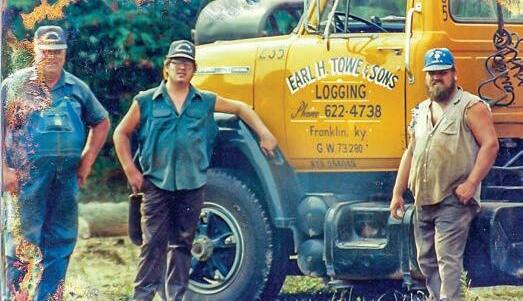

I was the middle of six children: Patricia, Rick, Roger, Terry, Pam, Billy. Daddy changed the name to Earl H. Towe and Sons Logging. I went to the log woods with my dad when I was small enough I could still stand up in the seat of the log truck and put my arm on daddy’s shoulder and ride down the road. My two older brothers started out doing the same thing. Our main job was, he said if something happens you go to that house and let them know what happened. Other than that I kept up with gas and oil for chain saws. We didn’t have winches then. We had hammer and smudge or wedges. I kept enough distance away in case the tree fell my way I’d be safe. He taught me where to stand.
We started getting old enough to start dragging logs out with the tractor. He wouldn’t let us use the saw but he let us use the tractor at 11 or 12 years old. As a kid that was so exciting. When my older brother Roger was 14, he had an accident; the tractor reared up, fell over and had him pinned. We had a Farmall tricycle type tractor, and daddy got the back wheels, picked it up off the ground and pulled my brother out from under-
Hammock-Wicks Timber, Inc., will be celebrating its 50th anniversary inApril 2023.The company was started by Lamar Hammock and evolved into HammockWicks Timber with the addition of his stepsons.One of the sons would later leave to embark on his own journey.The company is now operated by Jason Wicks,COO of the company after Lamar Hammock retired.
neath. He spent some time in the hospital but he recovered. Dad told us he would rather we ride the clutch so if it reared up we could clutch it. Two years later the same accident happened with me. A log got hung between a tree and stump and it threw me forward; the tractor reared up but when it came down it bounced my foot off the clutch. The steering wheel bolt was in my chest and my back was in the snaking dogs and it was mashing me to death. Daddy got between me and the tractor, got the choke open and the motor died. My mom told my dad, “Earl, if you’re gonna have them boys logging with you then you better get them something to log with, or I will burn every tractor you’ve got.” The track loader and skidders came after that, and we thought logging can’t get any better than this.
When daddy looked at timber, he was so good he could tell how much footage was in a tree. He couldn’t hardly write his name, but you couldn’t beat him in figures and math. Daddy was a Christian; he gave his life to the Lord at a tree stump in the log woods. One time he thought he made too much money on a deal. He didn’t feel right about it, so he gave them more money.
He was a gentle giant later but when he was a younger man…well, he had a mule to plow the garden. They say mules are stubborn but this one wrote the book. One day that mule reared up on him; daddy hit that mule in the nose and took him down to his knees with one blow from his left hand. After that the mule finished the garden pretty good. This was before he become a Christian, and he was ashamed of it later, but that’s how a big a man he was, a real “hoss” of a man.
Daddy logged for 54 years. He sold to my brother Roger in 2005 so he could take care of my mom after she had a brain aneurysm. Roger called it Towe Logging and logged till six years ago; he had a massive heart attack and passed away in 2016.
I’m 60 now, and still in the wood industry, hauling mulch, sawdust and slabs as Terry G. Towe and Family Trucking in Franklin, Ky.
■ I first read Southern Loggin’ Times at 13 years old and it carved a river in the sand of my
life immediately. My dad owned warehouses and my mom was a science teacher; I did not come from a logging family. But my friend had a neighbor whose dad was a procurement forester for Canal Wood. He had the magazine by his Lazy Boy recliner. On the front was a skidder. I turned my head sideways and asked to look at it. I was struck; that was it. I tried to go to my friend’s house any chance I could get, but I didn’t care as much about my buddy, I just wanted to see more of that magazine. It has compelled me ever since to be who I am today.
I’m 55 now and I am that logger that I read about 40 years ago in that magazine. It impacted me as I have grown though the years and I’ve talked to other loggers who tell me the same thing I experienced. When we get home each month and get SLT in the mail, we can’t do anything but look through it page-to-page, front to back. That’s how intriguing it is and how important everything in that magazine is to our business: we have to go through it as soon as we get it, then I can go on with the rest of my day or evening. I used to think it was just me who was like that but then I heard Chip Capps say the same thing at a CLA meeting, and I looked around that room and saw all the guys nodding their heads: yeah, it does me the same way.
C.K. Greene, Virginia
■ I logged in Florida for years. Jennifer McCary did an article on us in the early ’90s when we got burned in 1992. I lost a cutter, loader and a skidder or two I reckon. The environmentalists did it; it happened right outside Daytona. It was investigated by several agencies and they told me they had to clear me first; it was easy to clear me because I didn’t have insurance.
I quit school two weeks into 7th grade and went to work. I started logging in 1976 till 1995, and then I stayed out for over 20 years except buying and selling timberland. I owned two farms in Alabama from 1971-92, in Bullock County, but I moved to West Virginia in March 1995. Georgia-Pacific wanted me to come up here for a business deal and they kept after me about it. Finally I did, reluctantly, and the day I drove up here, I bought a farm on a whim. I moved because God had a plan, but G-P didn’t know that and I didn’t know it for a few years. Then from 2003-2010 I was in Missouri. I bought 3,000 acres in Missouri and ran cattle there, but I came back to West Virginia. The Lord has been good to me, a man with a 6th grade education.
I got back into logging in October 2018. I ran a small crew the first year and then we just keep expanding; it’s clearly the hand of the Lord. I’m not that heavy in debt; I just bought another 300 acre farm, and a brick home and a tree cutter last year, and paid cash for it all. Hard work pays off, that and the Lord.
Since I got back into it, logging has never been better. I’m nothing special, but I am a prayer warrior. I go to work at 1:30 every morning and get up at 11:30 to pray. God showed me to pray that He would turn the negative into the positive. We pray that every day on my job, I pray it at home, and God has turned the negative into a positive. We are getting record prices for wood up here.
The timber industry is changing and if you don’t change you’re gonna get left behind. It’s not so much the equipment as it is the help. The key is how you treat people, how you treat your employees. I don’t want to live above my help. I pay my help union scale wages and I say a prayer with
them every day, and not a two-minute prayer; we pray in depth. God is the giver of everything. What you hold in your hand shrinks; what you give away God will bless. My daddy told me when I was 11 years old: you will never out give the Lord, and I have found that to be true. You will get out of this life what you put in it.
Jack Griffin, 68, in Greenbrier County, West Virginia
■ From Tim J. Murphy, who worked at Tree Farmer Equipment Co., 1977-1986; Blount, Inc. (Prentice, Hydro-Ax, Blu-Ox, CTR, Fabtek), 1986-1996; Pioneer Machinery, 1996-2000; and Nortrax, Inc., a division of John Deere, 20002019:
Congratulations to Hatton-Brown Publishing on the 50th Anniversary of Southern Loggin’ Times. When I began my career in 1977, I was a naïve young Wisconsin kid being introduced to the world of “southern logging” with my first job with Tree Farmer Equipment Co. in Waycross, Ga. It began a love affair with an industry that I remained a part of for my 42-year career.
I received a lot of guidance in 1977, but one of the best tips was “boy, read the Loggin’ Times every month…it’s the bible of this industry down here!” It was still the “Loggin’ Times” until the title changed to “Southern Loggin’ Times” in 1981. But I was a convert, and although I was not technically eligible, I proudly displayed a bumper sticker procured from SLT that said, “American by birth, southern by the grace of God.” I consider myself extremely fortunate to have been able to meet and have a long professional relationship with DK Knight and Dave Ramsey. These two will never know the extent of an impact they have had on this industry, where they brought visibility, including the love, hate, sweat, trials, sacrifices and conviction of southern loggers and their families to the forefront every month. The “bible” it surely was.
When I first arrived in Waycross, mechanization was just at the forefront. A financially healthy logger was focused on three loads a day or 150 cords a week. The three-man crew ran a cable skidder, a small dozer or turned around skidder with a Roanoke directional shear and a log loader, usually one mounted on the back of a cab. If you hit those three loads a day, the kids ate well, and momma had nice clothes! Boy have things changed, and I consider myself extremely lucky to have met and engaged with the greatest innovators of logging equipment in the game. Some of those brands are not around anymore and some of them are, but they all had “chips” on the table in terms of defining the industry today as we know it.
Tree Farmer is gone but was instrumental in
Frank Bearden, of Summerville, Ga., seen here with his first homemade skidder,started logging in 1971 and retired in December 2021,50 years later.His son Greg Bearden,after battling leukemia,took over the family business last year.
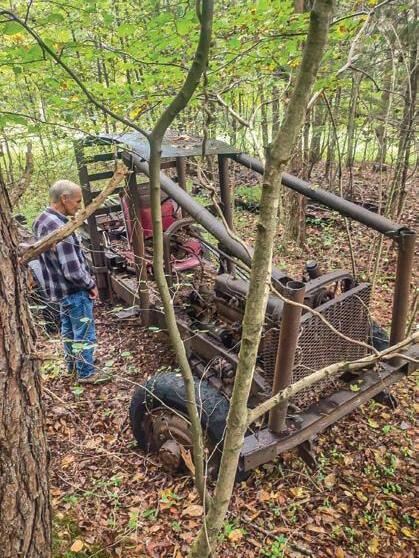
introducing one of the first skidders. Pat Doyle, Phil Crider, Johnny Ward, and Vic Morrish fed a lot of families with their efforts. I was honored to give the eulogy at Pat’s funeral. Franklin is gone, but I knew Rodger Drake personally, as well as Tom Morgan and Ken Trowbridge who started Tidewater Equipment Co. They were three of the South’s finest gentlemen. Franklin was king of the show in the Southeast for many years.
Timberjack was a mover and shaker and nobody moved and shook more than their incredible field team of John Martin, Doug Landers, Gary Vallencourt, Chuck Ghee, and Wally Buchanon. Competitors first, but equally close friends. John Deere was fortunate to pick up that company as Timberjack was leading and there was not a close second.
Believe it or not, Clark had a significant presence in the southern skidder game, primarily due to a few key dealers. Gordy Simms cemented many relationships between manufacturer and logger and was a key reason many continued to buy Clark.
Prentice loaders were invented by Leo Heikkinen, a product that changed logging history. I have sat with him at his kitchen table in Prentice, Wis. That loader was known as Prentice, CAT and now Weiler…and I saw a Weiler loader at a show last spring and it sure does look a lot like the old Prentice! It just would not seem right to Mal Crawford to have a “Weiler Loader Contest,” as Mal earned the love of loggers all over the U.S. with the Prentice Log Loader Championships. Mal was a co-worker and friend.
Timbco is now Komatsu, but Komatsu does not have Pat Crawford. I never got to sell his product, but I have had more meals and visits with this competitor than anyone in the industry. He stayed with us a long time, but then again, he left us too soon.
Barko was the creation of Maurey Bartel. But Bob Oglesby and Joe Woods created its legacy in the South. Joe left us too early, but I can still hear his laugh. No one, and I mean no one, could make a friend or tell a story better than Joe.
Husky loaders were part of the lineup for many southeastern loggers. As Prentice, Husky, Barko and Hood were all built within one hundred miles of each other in northern Wisconsin and Minnesota, those folks had to not only “walk the walk” but “talk the talk.” Dennis Healey made that happen for Husky. He was quite a guy. “How y’all doing” was a bit of a stretch for a guy used to saying “oh…you betcha!”
Len Vizina and Jimmy Mitchell changed the production game for southern loggers with Hydro-Ax, the first hydrostatic feller-buncher carrier. The market soon followed but those two friends put the blood and sweat into making it a
reality. It too went the round of CAT and Weiler, but the one I saw earlier this year had Hydro-Ax in its DNA!
I did not know the inventor of Esco grapples, but I knew Roy Zenor and his Weatherby Rifle promotion to sell ESCO grapples is arguably the best logging equipment promotion ever undertaken. The pre-manufactured “saddle” Esco produced exclusively for skidder manufacturers assured an easy match up for skidder dealers…and a lot of axle part sales as those 3500-lbs. attachments were added to the back of cable skidders!
Koehring and Harricanna came out of the gate with the high-speed sawhead. Do not know those inventors either but I know Jerry Mallory helped Koehring win that race. Tough to find a nicer guy than Jerry. Georgia-Pacific was the first to offer loggers 50 cents a ton to buy one as they got a better quality tree, but they quickly rescinded that when they found out how much more loggers could produce.
You may not remember Drott feller-bunchers but if you ever met Erv Drott, you never forgot him.
Some do not remember when Gafner Iron Mule produced their product in Eufaula, Ala. Tom Gafner had the vision and Kenny Knauf left his UP Michigan roots and kicked the can around with the “southern boys” for a couple of years. It was a valiant effort, but forwarders were just not going to be the way to bring wood to the landing once advanced mechanization took hold.
Bell came out of the “sawhead” race with a less than perfect solution but taught the industry how to market. Paul Bell brought the product over from South Africa, but it was Rene Cuchens who turned hamburger into steak. She created the “sizzle.” I will always respect Rene’s talent.
There is no better example of southern hospitality than that represented by the folks at CTR. Calvin Johnson, Ralph Metcalf and Tommy Hamby were some of the smartest people I know, while at the same time leaving you with simply a down home country feel. You just felt good doing business with these people.
Every competitor laughed at the “Tifton Demo” in 1992 when a Tigercat feller-buncher tipped over due to an inexperienced operator and high winds. Nobody is laughing today as Tony Iarocci, the Pat Crawford of Canada, developed a personal relationship with loggers and dealers to make Tigercat a premier player in not only southern logging, but across the world. When they introduce a new product, competitors better watch out as they surely did their homework.
As I spent a lot of time representing manufacturers Tree Farmer, Blount, and John Deere, I encountered a lot of dealers and dealers are where the rubber meets the road (in most cases dirt roads). I have mentioned a few already, but there are some standouts that clearly moved the needle.
Pioneer Machinery led by Gar Scott was an icon. But Pioneer players Maxi Coleman, Bubba Byrum, Ricky Callaway, Greg Callahan, Ricky Kennett, Paul Leas and many others carried the water. They knew how to work, and they knew how to have fun.
Ben Reavis and Walter Kitchens are two standouts I recall from Tidewater Equipment Co., but to be that good for that long there were others for sure. Tidewater, a remaining legacy.
Everybody in East Texas knows Harold Estes. Texas Timberjack is a legacy dealership started by Harold from the school of hard knocks starting with his youth in Cherokee, NC. Still knocking it out of the park.
Pictured with Bill Murray (no,notTHAT Bill Murray), right,ofYancey Bros.,Alton C.Moore,left,owner of Forest Products Inc., was featured in SLT in 1979. His sons,Danny andTyrone Moore,worked for him.After WWII, Moore became a short pulpwood hauler and later a treelength logger for Georgia Kraft in Macon.In the early ’70s he contracted with IP in Eatonton.When that mill closed in 1981 he sold out. Moore lived till 2015,passing at the age of 89.
Joe Parker compiled a dominant team in S&M Equipment and McIntyre Equipment. Cannot think of a company that had more respect for customers in North Carolina and Virginia. All part of James River Equipment today.
Knight Equipment continues today through the sons of Donald Knight, Jr. But Donald Knight literally took nothing and made it really something, always prepared to do what it took…meaning he would do it himself at 1:00 A.M. if nobody else would. Early on, Reagan Fox and Terrell Smith operated a branch for a while in Perry, Fla., the home of Roy Deals oyster house! His boys still operate with that philosophy.
Rex Smith and Luke Turner took experience from their days at West Georgia Equipment Co. and Ross Equipment Co. and built Smith and Turner Equipment as a mainstay in the foothills of north Georgia. Two great guys who remain in our memory.
Nobody has more information at their fingertips than Gene Ray Taylor from Warrior Tractor. There is not a bigger “Bama fan” either. An amazing businessman.
King Power was “king” for a while. If you looked up hard work in the dictionary you’d see a picture of Gary Vallencourt and Doug Landers. Kenny Rogers wanted to grow up to be like Garlin Gore one day, so he just dressed up like him!
You have not lived until you attended a fish fry from Gene Hawkins and Bernie Heathcock at Flint Equipment. They sold the business, but their memory lives on. No two finer gentlemen on the planet.
Nobody knew their balance sheet better than Brad Beard and he built one heck of company. Family today runs this outstanding John Deere dealer in southern Alabama and north Florida. W.J. Bates did the same over in southern Mississippi. What he built, his family continues to make stronger with B&G Equipment. CAT dealer Puckett Machinery quickly dispersed the idea that CAT dealers are “stuffy.” Richard Puckett is as down to earth as one would ever want and so was his team. Hard to find a better group of folks.
They have been around and will continue to be around, as Arkansas does not get any better than Suttle Equipment Co. Those folks just simply make you feel part of their family.
Of course, none of these companies nor their dealers would have had one ounce of success without customers. Southern loggers and customers are not immune from their fair share of, let us say, “deplorables.” But without question, the vast, vast majority are some of the finest people on earth. Several remain in my memory, and I am a better man for having known them:
● Vandel Redman led the way for black loggers in south Georgia; Richard Green did the
same for black loggers in Virginia.
● J.V. Gowan took this naïve “Yankee” and made him feel at home.
● Earl St. John was not southern, but his impact benefited every southern logger working today.
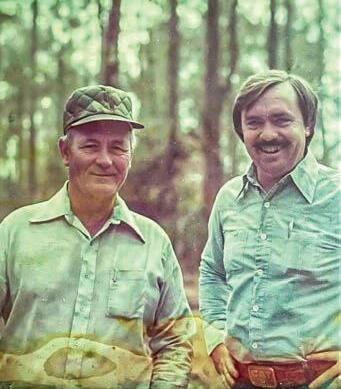
● Allen Bedel: proud to serve on the Executive Committee of the Forest Resources Assn. with him. He a logger, and me an “equipment guy.” We taught those woodlands guys a thing or two.
● Joe Young: they do not get any more honest than Joe.
● Matt Rigoni was the definition of innovation in Florida, as M.M Wright was the definition of innovation in Virginia, T.R. Goodson in North Carolina, J.C. Doolittle in South Carolina, Buck Beach in Mississippi, Doug Story in Georgia, Jimmy Johnson in Alabama, Lonnie Smith in Texas, Steve Richardson in Arkansas, and Wayne Wiggins in Louisiana.
● Rocky Creek Logging: sorry, company owned jobs just were not as efficient as individual loggers, as they are spending somebody else’s money! Good folks though.
● Bill Thomas defined “big” in South Georgia.
● Larry McCorkle came to my 30th birthday party…38 years ago!
● Tracy Gunter: did anyone ever work harder…or smarter?
● The Byrd boys…oh, the stories!
● Donnie Nipper: just an all-around nice guy…and pretty darn good logger.
● Reagan Fox: equipment guy to logger…if you can’t beat ‘em, join ‘em!
● Dennis Carey: one of the brave souls to try CTL in the South
● Tommy Burch: I still have his daughter’s book, may she rest in peace.
● Gerald Anderson was one of the first loggers to get elected as a politician.
● A thousand more…but I am running out of paper!
I have had the privilege of being a part of this industry for 42 years. I have called on logging contractors all over the world and in all regions of the U.S. and Canada. Nobody, and I mean nobody, is more fun and enjoyable to call on than the southern logger. I still get the Southern Loggin’ Times at home after retirement, and I immediately go through it front to back. Occasionally, I will read about an old friend.
I’ve either broke bread, shared a little vibration, prayed or been to the woods or office of everyone that I have mentioned in my tribute to the Southern Loggin’ Times. I consider myself to be one lucky man for doing so. So, to HattonBrown Publications, CONGRATULATIONS... and remember, the first 50 years are easy...it is the next 50 years that you have to buckle down and go to work.


Five surgeons were taking a coffee break and discussing their work.
The first said, “I think accountants are the easiest to operate on; you open them up and everything inside is numbered.”
The second said, “I think librarians are the easiest to operate on; you open them up and everything inside is in alphabetical order.”
The third said, “I like to operate on electricians; you open them up and everything inside is color-coded.”
The fourth surgeon said, “I like engineers because they understand when you have a few parts left over at the end.”
The fifth one said, “I like to operate on lawyers; they’re heartless, spineless, gutless, and their heads and their butts are interchangeable.”
Right or left doesn’t matter.It’s really up or down.
—Whatever you may look like, marry a man your own age. As your beauty fades, so will his eyesight.
—Housework can’t kill you, but why take a chance?
—Cleaning your house while your kids are still growing up is like shoveling the sidewalk before it stops snowing.
—The reason women don’t play football is because 11 of them would never wear the same outfit in public.
—Best way to get rid of kitchen odors: eat out.
—A bachelor is a guy who never made the same mistake once.
—I want my children to have all the things I couldn’t afford. Then I want to move in with them.
—Most children threaten at times to run away from home. This is the only thing that keeps some parents going.
—Any time three New Yorkers get into a cab without an argument, a bank has just been robbed.
—We spend the first 12 months of our childrens’ lives teaching them to walk and talk, and the next 12 years telling them to sit down and shut up.
—Burt Reynolds once asked me out. I was in his room.
—What I don’t like about office Christmas parties is looking for a job the next day.
—The only time I ever enjoyed ironing was the day I accidentally poured gin in the steam iron.
—His finest hour lasted a minute and a half.
—Old age is when liver spots show through your gloves.
—My photographs don’t do me justice. They just look like me.
—Tranquilizers work only if you follow the advice on the bottle—“keep away from children.”
—I asked the waiter, “Is this milk fresh?” He said, “Lady, five hours ago it was grass.”
—The reason the golf pro tells you to keep your head down is so you can’t see him laughing.
—You know you’re old if they have discontinued your blood type.
These messages were spotted on the signs of churches: Can’t Sleep? Try Counting Your Blessings.
Honk If You Love Jesus. Text While Driving If You Want To Meet Him.
What Is Missing From CH—CH? UR. Aspire To Inspire Before You Expire.
There Are Some Questions That Can’t Be Answered By Google.
Every Day Above Ground Is A Good One.
The Best Vitamin For A Christian Is B1.

Adam Blamed Eve, Eve Blamed The Snake, And The Snake Didn’t Have A Leg To Stand On.

Thou Shalt Not Steal The Copper From The AC Unit.
Try Our Sundays. They’re Better Than Baskin-Robbins. To Be Almost Saved Is To Be Totally Lost.
Try Jesus. If You Don’t Like Him The Devil Will Always Take You Back.
Church Parking. Trespassers Will Be Baptized.
Read The Bible. It’s User Friendly. Plus We Offer Tech Support Here On Sundays At 10:30.
You Are Not Too Bad To Come In Or Too Good To Stay Out.
God Cared Enough To Send The Very Best.
Walmart Isn’t The Only Saving Place In Town.
ATM Inside—Atonement, Truth & Mercy.
Free Coffee, Everlasting Life. Yes, Membership Has Its Privileges.
Forgive Your Enemies. It Messes With Their Minds.
Don’t Be So Open-Minded That Your Brains Fall Out.
God So Loved The World That He Did Not Send A Committee.
Tomorrow’s Forecast: God Reigns & The Son Shines!
If God Had A Refrigerator Your Picture Would Be On It.
Can’t Sleep? Counting Sheep? Talk To The Good Shepherd. Read The Bible. It Will Scare The Hell Out Of You.
Don’t Wait For Six Strong Men To Bring You To Church.
Download Your Worries—Get On Line With God.
God Help Me To Be The Person My Pet Thinks I Am.
Prayer: Free Wireless Access.
Why Pay For GPS? Jesus Gives Free Directions. Do Not Criticize Your Wife’s Judgment; Consider Who She Married.
Don’t Give Up. Moses Was Once A Basket Case.
If you can read this, you’re standing on my boobs!
I told you I was sick.
I was hoping for a pyramid.
Raised four beautiful daughters with only one bathroom, and still there was love.
Now I know something you don’t.
Here lies an atheist: all dressed up and no place to go.
That’s all folks. (On the tombstone of Mel Blanc, man of 1,000 voices, including Bugs Bunny.)
Here lies John Yeast. Pardon me for not rising.
It’s dark down here.
Go away! I’m asleep.
I came here without being consulted and I leave without my consent.
She always said her feet were killing her, but no one believed her.
Jesus called and she answered.
The shell remains but the nut is gone.
Here lies Clyde. His life was full…until he tried to milk a bull.
Here lies Lester Moore. Four slugs from a .44. No Les, No More.
Here lies the body of Deanna…Done to death by a banana. It wasn’t the fruit that laid her low, but the skin of the thing that made her go!
I made some good deals and some bad ones. I really went in the hole with this one.
When God solves our problems, we have faith in His abilities. When God doesn’t solve them, He has faith in our abilities.
Three friends decided to go deer hunting together. One was a lawyer, one a doctor, and the other a preacher.
Locked and loaded, they were about to head for their designated stands when a big buck unexpectedly emerged from the brush, well within range. The three of them shot simultaneously. The buck dropped to the ground and all three rushed up to see how big it actually was.
Upon examining the deer they found only one bullet hole. Thus a debate followed concerning whose buck it was.
A few minutes later a game officer came by and asked what the problem was. The doctor told him their reason for the debate. The officer told them he would take a look and offer his opinion. Within a few seconds he said with much confidence, “The preacher shot the buck!”
They all wondered how he knew that so quickly, and the officer explained: “Easy. The bullet went in one ear and out the other.”
A Baptist preacher in a small Southern town went to visit a member of the community and invited him to come to the church that he led.
It seemed that this man was a producer of fine peach brandy. He told the preacher that he would attend his church if the pastor would drink some of his brandy, and admit doing so in front of his congregation. The preacher agreed and drank up.
On Sunday morning, the man visited the church. The preacher recognized the man from the pulpit and said, “I see Mr. Johnson is here with us this morning. I want to thank him publicly for his hospitality this week and especially for the peaches he gave me and the spirit in which they were given.”
—The task ahead of us is never as great as the Power behind us.
—The will of God never takes you to where the grace of God will not protect you.
—We don’t change the message; the message changes us.
—Life without God is like an unsharpened pencil: it has no point.
—The best mathematical equation ever: 1 cross + 3 nails = 4 given

The older man had an appointment to see a urologist for a prostate exam. He was a bit on edge because all his friends had either gone under the knife or had pellets implanted. The waiting room was filled with patients.

He approached the receptionist’s desk and gave her his name, noticing that she had a sour look on her less than attractive face.
In a very loud voice, she said, “Yes, I have your name right here. You want to see the doctor about impotence, right?”
All the patients in the waiting room snapped their heads around to gaze at the now very embarrassed man. But he recovered quickly and boomed back at the receptionist: “No, I’ve come to inquire about a sex change operation, but I don’t want the same doctor who did yours.”
The room erupted in applause!
Acme Plumbing: We Repair What Your Husband Fixed Morrow Mechanical: A Call To Morrow Is All It Takes Specialty Painting: Sure, We’re Expensive…But We’re Slow!
Total Plumbing: Our Business Is Going Down The Drain Sensational Sprinklers: When We’re Finished, You’ll Be All Wet
This is what happens when you give Red Bull to an overzealous woodpecker.

—God doesn’t propose to judge a person until after death. So why should you?
—We’re called to be witnesses, not lawyers or judges.
—Be ye fishers of men. You catch ’em, He’ll clean ’em. —Coincidence is when God chooses to remain anonymous. —Don’t put a question mark where God puts a period.
—Forbidden fruits create many jams.
—God doesn’t call the qualified; He qualifies the called. —God grades on the cross, not the curve.
—Many folks want to serve God, but only as advisers. —It’s easier to preach 10 sermons than it is to live only one. —When you get to your wit’s end, you’ll find God lives there. —God loves everyone, but probably prefers ‘fruits of the spirit’ over ‘religious nuts!’
—God promises a safe landing, not a calm passage.
—If God is your co-pilot, swap seats!
—Don’t give God instructions, just report for duty!
Tri-State Excavation: We Dig What You’re Sayin’… Waste Disposal Services: Our Business Stinks…But It’s Picking Up Cosmic Construction Co.: We’re Proud Of Our Erection Bill’s Septic Service: Satisfaction Guaranteed Or 100% Of Your Product Back
Martial Arts 2: Building Kids One Punch At A Time Quad Cities Dental Clinic: We Do Our Business In Your Mouth Dad’s Dog Food: We’ve Gone To The Dogs For 30 years Lawn service: Mow For Your Money
Nail salon: If You Break It We Can Fake It Beauty salon: If You Don’t Look Good, We Don’t Either Spa: It’s Great To Be Kneaded! Electric service: We Are Shockingly Good At Watt We Do! Country of Israel: Size Doesn’t Matter Country of Egypt: Where It All Begins
“I’m not available right now, but thank you for caring enough to call. I am making some changes in my life. Please leave a message after the beep. If I do not return your call, you are one of the changes.”
Three men were hiking through a forest when they came upon a large raging river. Needing to get to the other side, the first man prayed, “God, please give me the strength to cross the river.” Poof! God gave him big arms and strong legs and he was able to swim across in about two hours, but he was almost pulled under twice.
After witnessing that, the second man prayed, “God, please give me the strength and tools to cross the river.” Poof! God gave him a rowboat and strong arms and strong legs and he was able to row across in about an hour after almost capsizing.
Seeing what happened to the first two men, the third man prayed, “God, please give me the strength, tools, and the intelligence to cross the river.” Poof! He was turned into a woman. She checked the map, hiked a mile upstream, and walked across the bridge.







Today, we celebrate 50 years of excellence and industry leadership.
Congratulations to Hatton-Brown Publishing Company and Southern Loggin’ Times for 50 years of integrity, editorial excellence, and unwavering dedication to the forest industry.
Your editorial staff do so much more than report on industry news, events, and product innovations. Your writers write about the lives of hardworking loggers, shaping the narrative of the men and women that drive our industry. We want to thank you for allowing us to honor this moment and join in the celebration of your hard work, commitment, and the dedication you share for the forest industry!
For more than a century, Komatsu has been creating value for its customers through manufacturing and technology innovation, partnering with others to empower a sustainable future where people, businesses and the planet can thrive together.
We value our customers, distributors, and shareholders for their partnership in serving the forest industry to make careers more fulfilling, our communities stronger, and to help our industry prosper.
As a leading manufacturer, we support our customers with world-class products including wheeled harvesters and forwarders, harvesting, processing and felling heads, track feller bunchers and harvesters, log loaders, forestry excavators, and dozers for virtually every application. Through our comprehensive distributor network our customers have trusted Komatsu to deliver proven forestry solutions and a range of heavy equipment backed with parts inventory and expert service from dedicated forestry professionals.
Our distributors are also proud to represent an outstanding lineup of

welcomes the opportunity to say Congratulations and Thank You to Southern Loggin’ Times. Fifty successful years speaks for itself regarding the leadership and the hard work of the entire staff. Thank You for developing the “Southern Logger’s Best Friend.” It is also the forestry equipment manufacturer’s best friend. Loggers like to read about loggers and no other publication covers this subject so well.
Maxi-Load was started in 1996 by a South Georgia swamp logger. It was the result of a search to control truck weights and to work in the wet and muddy conditions associated with swamp logging. At the beginning there was never a thought of selling scales. It was all about finding a solution that would work where we worked, be trouble free, and accurately control our truck weights. After the first unit was successful, word spread, and units 2 through 6 sold in the local area. In 1997 Maxi-Load ran its first advertisement in Southern Loggin’ Times. Southern Loggin’ Times put Maxi-Load in the scale business. The difference between being “Almost Loaded and Fully Loaded” is a whole lot of money.
It is the conditions under which Maxi-Load started that support our statement “If You Can Load There – We Can Weigh There.” The initial requirement to work on a swamp logging job was also the foundation of a very durable and trouble-free product. That first scale built in 1996 still
forestry brands including Komatsu, TimberPro, Log Max, Quadco, Southstar, and more.

Komatsu develops and supplies technologies, equipment and services for the construction, mining, forklift, industrial and forestry markets. For a century, the company has been creating value for its customers through manufacturing and technology innovation, partnering with others to empower a sustainable future where people, business and the planet thrive together. Front-line industries worldwide use Komatsu solutions to develop modern infrastructure, extract fundamental minerals, maintain forests, and create consumer products. The company’s global service and distributor networks support customer operations to enhance safety and productivity while optimizing performance. Komatsu.com
weighs trucks today. All day, every day. We have never tried to build the cheapest scale. Our objective has always been to build the best scale. Logging is a profession that requires a quality product. Several upgrades have been added over the years. We work constantly to improve the scale we build and to service the customers we have.
Each scale sold has brought new friends. Over the last 26 years we have dealt with some of the finest people on earth; 99% of them have been loggers. The help we have received from customers, other equipment manufacturers, dealers, and their sales representatives has been unbelievable. Vulcan On-board scales has partnered with us since the beginning.
Southern Loggin’ Times opens new doors each month. Thanks to all for all you do!
In 1804, a man named John Deere was born in Rutland, Vermont. Just 33 years later, Deere would start a company with a revolutionary plow fashioned from a broken sawmill blade. This humble start would go on to help America—and the rest of the world—grow for nearly two centuries.
John Deere’s journey, from boyhood to founder and president of John Deere, closely parallels the settlement and development of the midwestern United States, an area that the homesteaders of the 19th century considered the golden land of promise.
The wild success of John Deere throughout the early stages of its growth as a business can be largely attributed to Deere’s ability to solve a crucial business problem in the Midwest—the inadequacy of their plows to handle the rich, heavy prairie soil.
After studying the problem John Deere fashioned such a plow in 1837, using the steel from a broken saw blade. Ten years after he developed this first plow, John Deere was producing 1,000 plows a year and he vowed: “I will never put my name on a product that does not have in it the best that is in me.”
Holding true to this commitment, John Deere spent the rest of the century developing cutting-edge machinery that transformed the brand from a one-trick pony into a well-known manufacturer of a full line of farming equipment.
It was in 1935 that the John Deere Model DI tractors made their debut, John Deere’s first tractor purpose-built for industrial use. Hard rubber wheels, extra low road gear, and options such as a winch, made it a practical machine for a wide variety of non-agricultural jobs.
In 1949, John Deere released the machine that would take the logging world by storm: the “MC” crawler. The “MC” earned high marks from loggers due to its prowess in tough terrains such as steep slopes and soft soil.

Just under a decade later, John Deere introduced the 440 crawler, a precursor to the changeover to all yellow machines the following year. The 440 also featured an easy-to-operate, inside-mounted hydraulic blade.
At this point, an important development to note requires us to look back on the founding of Timberland machines in Woodstock, Ontario in 1947. They started as an independent company producing products for the logging industry. We say this because in 1961, shortly after the release of the 440 crawler, Timberland Machines released the Timberjack 200 series skidder. Available with a 61-horsepower Ford gasoline engine, the first articulated skidder to bear the Timberjack name had a suggested list price of $8,925.
Competing with this, John Deere changed the game in 1965 with the release of the 440 skidder. Before its arrival,
wheeled skidders were little more than an engine in a frame. The 440 brought operator comfort into the equation to increase safety and productivity.
Then, in 1977, John Deere unveiled the 743 Tree Harvester, which combined the speed of rubber tires with the reach of a boom, allowing operators to harvest two trees a minute as it paved the way for today’s modern harvesters.
At this point in time, the farming, and forestry equipment industry as a whole, was growing by leaps and bounds. Other companies, some of which bear names that are now household, began to populate the field. For John Deere, the development of these companies would soon become integral to their own business operations and partnerships. In 1986, Rauma-Repola Forest Machine Group was negotiating with Caterpillar and acquired 60% of the French manufacturer Cemet-Agrip and entered into a co-operation with Timberjack. Timberjack, which was born of the Timberland Machines that we learned of in the late 40s, was purchased by John Deere just three years later in 1989.
Feeling the heat, Rauma-Repola promptly re-purchased 100% of Timberjack back and renamed the group FMG Timberjack in 1990. In the following year, Rauma-Repola merged with Finnish company United Paper Mills and FMG Timberjack was attached to Rauma-group. FMG Timberjack soon regained its original branding as simply “Timberjack” in 1994.
Jumping ahead, John Deere later purchased Timberjack and Waratah in 2000. This addition brought new technology and R&D assets to the brand as well as solidified John Deere as the worldwide leader in forestry,

As the brink of the twenty-first century approached, John Deere began to emphasize a user-centric design approach to keep up with the changing times. In 1997, customer and dealer feedback was brought into the design process through the formation of dealer and customer advocacy groups, known as DAGs and CAGs. This user-centric approach to design was another John Deere first.
To this day John Deere lives up to the legend by forging industrychanging innovation while fulfilling requirements and driving continuous improvement. Through growing challenges comes the company’s dedication to innovating while remaining committed to producing highquality machinery. This has made John Deere the leader in the forestry and logging industry, delivering customer-driven solutions for over 50 years.
Equipment like the John Deere 768L-II bogie skidder boasts the ruggedness and reliability needed in the woods with innovative technology to optimize productivity. Loggers gave their feedback and John Deere listened. The launch of Precision Forestry simplified the John Deere technology portfolio, making it easier for customers to select and adopt customized solutions based on their unique jobsite needs. And with the introduction of Intelligent Boom Control, John Deere redefined boom operations for enhanced precision and efficiency. This technology makes it easier to control all boom movements giving operators a new level of control over their logging operation and bottom line.
Since 1983, Bandit has manufactured equipment for a multitude of wood waste processing markets. The vision since the beginning is to build quality, highly productive, easy to maintain equipment providing years of dependable service. The commitment for quality, innovation, and dedication is instilled in every employee and is one of the main reasons why Bandit became an Employee-Owned Company (ESOP) in 2018.
A wide variety of products are available, including hand-fed and whole tree chippers, track forestry mulchers, horizontal grinders and slow speed shredders.
Bandit’s line of whole tree chippers includes drum-style chippers with capacities ranging from 20” to 36.” Each drumstyle chipper excels at pulling and compressing trees into the chipper with Bandit’s patented slide box feed system. This system makes the chipper easier to feed by reducing the need to re-position or remove material from the feed system. Additionally, Bandit drum-style chippers are designed to throw material at a greater velocity to fully load chip vans, ultimately reducing the number of trips to the dump site. Most of these drum-style chippers can be ordered as track and select models are available with loader and cab / loader options.
To further enhance Bandit’s line of whole tree chippers, in December of 2021 the announcement was made that Bandit would be purchasing the Trelan company. Trelan disc chippers have been manufactured since the late 1970s and are known to produce a high-quality paper chip. This product line addition has increased the diversity of the whole tree chipper line


Russ Wood of J.M. Wood Auction Co., Inc., looks back:
“Southern Loggin’ Times was founded in Montgomery in 1972, just three miles down the road as the crow flies from our corporate headquarters in Montgomery. My father, Malcolm Wood, was one of DK Knight’s first subscribers and he immediately realized the impact that a publication like that would have on the timber industry and in his own auction business. So when he inked a deal to do his first major logging equipment auction for “Dunham’s Log Hog” manufacturing in Bossier City, Louisiana, he reached out to Mr. Knight to help promote it. That auction was a great success and my father knew that the exposure through Southern Loggin’ Times played a major role in making it so. And as our business grew, we ‘danced with the one that brought us,’ relying upon Knight and his publication for exposure and marketing expertise as we conducted logging machinery auctions for equipment industry titans such as Garr Scott, Gene Taylor, Chris Cannon, Johnny Ward, Donald Knight, Ricky Callaway and more throughout the 1980s and on.
“My father passed away in 1990, and my mother, Brenda, was determined to not only defend his legacy but to grow it. One of her first hires was Garlon Gore, co-founder of KingPower Equipment, one of the first Timberjack forestry dealers in the Southeast. Mother recognized Garlon’s innovative spirit and character as a leader and she recruited him from ‘retirement’ when he sold his business in the 1990s. This hire eventually led to an even closer relationship between our company and Southern Loggin’ Times
“Garlon was a relationship man. Plain and simple. And one of his closest relationships was with DK Knight and the SLT team. Garlon and DK worked well together, recognized opportunities as they presented themselves, and relied upon one another to see those opportunities manifest into results. One of our favorite memories of working with the DK and SLT team was the 1998 Southeastern Logging Expo in Baxley, Georgia. DK called us and wanted us to do an onsite auction at the expo and we agreed it was a great idea for both of us. We had a couple of local loggers and dealers that were excited to participate as well. It was going to be a drive-through auction that brought the equipment by the tent for the customers to bid. A few days before the auction it started raining and did not stop. We had to winch the machinery across the auction ramp because the skidders were sinking to the frame on the expo site!
now offered by Bandit.
Depending on the area, Bandit’s whole tree product line is either directly supported by Bandit or a dedicated dealer. Bandit dealers invest substantial resources to support the Bandit products they represent. This involves dedicating parts, sales, and service personnel, in addition to investing resources into tools, trucks, machine inventory / parts, and more. This commitment ensures each Bandit customer will receive top notch aftermarket support.
To learn more about Bandit whole tree chippers or other products offered please visit www.banditchippers.com.
“And mother’s dedication to growth, not only overall, but specifically in logging and forestry equipment, was reflected in two more hires in the late ’90s and 2000s. JD Gray, Vice President, and Trey Murphy, Forestry Division Manager, have been integral to our growth in this sector. JD had been with Mack Trucks for 20 years prior to joining our team. Trey had been a dedicated forestry representative with Pioneer Machinery and Yancey Caterpillar. JD and Trey have been responsible for winning many one-owner forestry and logging auctions across the Southeastern United States.
“Later, in 2006, Paul Leas called us on a Friday afternoon in August and asked us to come to Columbia, South Carolina the next week to discuss putting on an auction for Pioneer Machinery and Cat Financial. Our next phone call was to SLT to get the ad deadlines and mail dates to determine how much time we needed to market this properly. We sat down with the SLT team and layed out a marketing plan. The auction was huge success for all six of the Caterpillar dealers involved and Hatton-Brown helped us get it across the finish line.
“Advertising is a funny thing. It’s often hard to quantify its success. I remember one of my marketing professors at Alabama telling a story about William Wrigley, founder of the Wrigley Company in Chicago. He said something to the tune of, ‘I know half the money I spend on advertising is wasted…I just can’t figure out which half!’ That stuck with me and I’ve remembered it often since I graduated and came back to work in the family business. But one thing is for certain: I know that our relationship with Southern Loggin’ Times works. Over the years, it’s been repeatedly obvious that we can set our clocks by the SLT mail date. When it hits its subscribers’ mail boxes, our phones start blowing up.
“The world is changing, and with it is changing the auction business and the publishing business. Both our company and Southern Loggin’ Times have evolved with the times, directing more and more focus to the internet. But our phones still start ringing when the latest issue of Southern Loggin’ Times drops, and we are proud to share a history of mutual success.”
Congratulations, Southern Loggin’ Times, on achieving 50 years of continuous publishing; it is truly a monumental achievement. Like your monthly subscribers, we, too, have enjoyed learning about the men and women who contribute daily to the growth and success of the southern logging market. Morbark celebrates its 65th anniversary this year, and we thought your readers might enjoy reading about what we were up to in 1972.
Several circumstances in the late 1960s led to the creation of Morbark’s signature product – the whole tree chipper. First, Dutch elm disease spread rapidly in major cities in the upper Midwest and southern Ontario. The disease had killed millions of elm trees worldwide by 1970. As a result, dozens of municipalities found themselves dealing with a challenging problem in the disposal of dead trees.
At the same time, a growing number of local and state governments, under pressure from environmental groups, were passing laws banning the open burning of debris generated in land clearing operations and construction projects. As a result, municipalities, tree care companies, and land clearing contractors were forced to turn to landfills to dispose of dead and downed tree trunks, branches, and stumps.
Urban tree companies were routinely using brush chippers to get rid of small trees and branches, but what was needed was a machine that could chip an entire tree to help them deal more effectively with dead elm trees. At this time, our founder, Norval Morey, began to think of the potential market for such a machine – not only those requesting it now but also for the production of in-woods chips that went into the making of building products like particleboard and flakeboard, and perhaps even pulp and paper products.
What they came up with was an apparatus that was well suited for handling bark-laden trees with broken and bent branches, trees with crooked trunks, and trees with leafy foliage. Moreover, this apparatus could crush

Founded in 1914 by brothers Goodloe and Earle Yancey, Yancey Bros. Co. began as the Yancey Hardware Company, selling hardware, picks and shovels to government agencies for road construction. From their Peachtree Street location in downtown Atlanta, the brothers became the first dealer in the United States for the Adams Mule Grader, a predecessor of today’s motor grader which was pulled by eight mules.

In 1918, the Holt Manufacturing Company of Peoria, IL boasted that its Model 45 tractor could do the work of “40 mules . . . or 40 horses and countless humans.” Goodloe and Earle traveled to Peoria to ask Holt if they could represent the product in the southeastern United States. Unable to secure a demonstration tractor, Goodloe and Earle left Peoria with only a photograph of the Holt Model 45 and a price quote of $4,750 per machine.

Yancey’s first Model 45 delivery came later that year to Troup County, Georgia. Within 12 months Yancey had sold all of the Model 45s in Holt’s inventory, using only a photograph. When Goodloe and Earle returned to
and fold branches to the tree trunk without the branches springing back as they entered the chipper. The machine was issued a U.S. patent in May 1972 and would become known as the Metro Chiparvestor.
Eager to prove the machine’s metal, numerous demonstrations were arranged throughout the country for woodland owners and paper mill operations, and disbelievers soon became believers. The biggest mill customers were Westvaco, Weyerhaeuser, Georgia-Pacific, and Masonite. Private landowners welcomed whole tree chipping as well, as the value of their timber resource was increased, and the leftover condition of the land made it easier and more economical for landowners to reforest or convert the land to another use.

This invention, now known as the Morbark Chiparvestor, has led to many logging and chipping practices still used today, an emphasis on whole tree utilization, and new markets for byproducts derived from wood waste processing.
the Holt factory in Peoria the following year, they were given Holt’s first jobber’s contract.
In 1925 Holt merged with Best Tractor Co. to become the Caterpillar Tractor Company. Caterpillar’s records indicate that, based on the original 1918 agreement, “Yancey is the dealer with whom Caterpillar and its predecessor companies have had the longest business association.” Thus, Yancey Bros. Co. is proud to own the title of “The Nation’s Oldest Caterpillar Dealer.”
TraxPlus has been serving its customers since 2013. As one of the South’s largest new and used forestry equipment dealers and featuring equipment from the leading manufacturers in the nation in construction, forestry, mulching, and ag equipment, we strive to make your business more efficient and successful.



We offer a variety of equipment brands like Barko, Bandit, Sany, Denis-Cimaf, ASV, Lamtrac, Shearex, Rayco, FAE, Massey Ferguson and more. We also offer a full range of financing options, warranty, parts and service to support your equipment. Keeping your business running is what we do!
You can also find us at our now five locations: Hickory, Summit, Columbus, MS, Alexandria, LA, and Bessemer, AL.
“IT MEANS MORE” is a motto that both our customers and employees live by! Do not miss your opportunity to be a part of the TraxPlus family and always feel at HOME!

The Quadco Group is made up of three well-known industry leaders: Quadco, Southstar, and Log Max USA. The company that has brought you innovation since 1989 began manufacturing saw teeth and discs 33 years ago. We have a strong presence in the Southeast since the beginning with a parts warehouse and manufacturing/service facility in Lexington, SC. Our success would not have been possible without the help of loggers throughout this great region. Quadco designs its equipment taking into account the types of forests, size of the trees, soil conditions, maintenance, types of base-machines, etc. Forest conditions vary greatly from region to region and the uniqueness of the Southeast has helped us become better. Carbide teeth and bunching saw heads for the plantations, intermittent saw heads and 360-Rotates for the hills and the swamps, are all products that were designed with input from our valued Southern loggers. You keep our attachments ahead of the game and we thank you for that.
From modest beginnings in 1989, over time, Quadco has expanded both through new product development as well as through business acquisitions. Southstar, for example, with its range of heavy-duty processors from BC and New Zealand, was acquired in 2016. Log Max USA, distributor of Swedishmade Log Max heads, acquired in 2018, gave access to a whole new family of harvesting/processing heads. These novelties have enabled Quadco to expand its product line into each territory where forestry plays an important role.

With over 165 team members worldwide, we are poised and ready to help you. Our headquarters are in St. Eustache, Quebec (near Montreal). We have locations in Rotorua, New Zealand; Kamloops, BC; Lexington, SC; and Kalama, WA. All locations provide service, parts, and sales support for all brands. Heads are produced in St. Eustache and Kamloops and Cutting Tools in Quebec and South Carolina.
As our President and CEO Dan Webb so aptly puts it, the key to Quadco's success is our people, and the great products we sell and service. Everyone is proud to be part of this team made up of individuals dedicated to the forest industry.
As Keith Hicks, VP Cutting Tools Division, Lexington SC, puts it, “Quadco is a brand that we can be proud of. They really are an industry leader. The company is committed to the industry. It makes products the industry really
needs - and they’re priced right. Quadco has been at it for over 30 years. They live and breathe it every day.”

Quadco is excited about recent steps forward, such as the new line of QPS teeth (Quadco Performance Series), the result of over 30 years of experience, and the most significant development in cutting tools in recent years, available in both steel and carbide. Quality, durable products perform longer and work harder, meaning lower operating costs for you the logger.
We look forward to being of service to you. Thanks to y’all. And thanks to Southern Loggin’ Times for 50 great years.
For nearly 50 years, loggers have relied on Waratah Forestry Equipment for versatile heads that are proven workhorses in the woods. Whether it’s harvesting; processing; felling; delimbing; working in softwood, hardwood or mixed stands; Waratah’s lineup of 200, 400 and 600 Series heads are up to the challenge.


“Waratah continues to be a key player in the Southern logging market, especially with providing loggers with reliable and productive heads as they’ve transitioned to processing applications,” said Brent Fisher, product marketing manager for Waratah. “We understand the importance of getting everything you can out of every piece of wood. We’re proud to manufacture innovative products for our customers that do that and more.”
With factories in New Zealand and Finland, Waratah pioneered mechanized harvesting and manufactured the original red head. With a long history in the forestry industry, Waratah continues to build on its past to innovate for the future – manufacturing more productive heads, engineering products with parts that don’t quit and earning each customer’s trust every day.
It’s not surprising that bold loggers across the globe continue to choose Waratah for their operations. Because while the industry has changed over the years, Waratah has always been Built To Work® – supporting its customers so they can outsmart and outperform the others.
“Thanks to our loyal customers, we’re looking forward to celebrating our 50th anniversary next year,” Fisher said. “It’s exciting because we’re in a unique position to offer customers experience, expertise and innovation.”
For more information, visit Waratah.com.
Southern Loggin’ Times first went to press in 1972, and just four years later, Andrew Pitts, Jr. built his first trailer. Pitts Trailers is proud to contribute to this special commemorative issue, sharing our story in celebration of SLT’s golden anniversary.

Currently Pitts Trailers is the largest forestry trailer manufacturer in the U.S., offering a full line of truck trailers, including log, loader and lowboy trailers. The family company built its reputation on decades of manufacturing durable, dependable forestry trailers, designed to perform in one of the toughest, most demanding industries. And it all started with that first trailer, built by hand in the woods of rural Pittsview, Alabama.
“The first customer was the Gas and Lumber Company of Eufalua, Alabama,” Andrew Pitts remembered in a 2016 interview. “I was in the trucking business then, hauling a lot of bark and sawdust to Georgia Craft down in Cottonton, Alabama. He asked me to get him a log trailer and I couldn’t find him one so we built him the first trailer in 1976.”

Pitts ordered the I-beams and the tubing, built the trailer, and took it down to Garrison. “He used it for 20 years and never did wear it out,” Pitts said. “We built about 12 in 1976, and then by 1983 or ‘84 we were in the full-time trailer business.”
Since its inception, Pitts Trailers has rooted the business in its founder’s ideal of building the highest quality products available. “I think we built a good product and we treated people right,” Pitts explained. “And if anything went wrong with anything we built, we made it right.”
Over the years, Pitts Trailers has also maintained a reputation for innovation, pulling the industry forward again and again. “I think the development of the Load Payin’ series was instrumental in the growth of the company,” recalled Jeff Pitts, Andrew’s son and current President, CEO and owner of Pitts Enterprises.
In 1994, the pioneering Loadpayin’ Series introduced a fully fabricated frame made of high yield materials with a continuous submerged arc welding process, making it possible to haul more wood

and less steel, while maintaining the highest performance standards available in the industry.
“We borrowed that technology from the flatbeds. Proving that it would hold up under a log trailer application was challenging, but now it accounts for about 85% of our production,” Jeff Pitts reported. Now the number one selling logging trailer in North America, the Loadpayin’ Series is available in multiple configurations to meet customers’ needs.
Pitts innovation struck again in 2003 with the Ultra Loadpayin’ Series, the lightest logging trailer in the U.S. for the largest hauling capacity to date. The lightweight fabricated mainframe is made of high yield steel with Domex ultra-light bolster. Like the original series, it is available in multiple configurations.
The most recent Pitts innovation, Lock ’N Go landing gear, was introduced in 2018 to significantly enhance operator safety and convenience. The four-pin auto-lock system allows a driver to easily ensure that both sides of the landing gear are securely engaged without circling or crawling under the trailer. It also helps secure the load and protect the trailer from unnecessary wear and tear.
Shortly after its inception, Pitts began producing lowboy trailers as well. Pitts’ Heavy Haul division delivers tier one quality at tier two pricing. Built with high yield materials and beam fabrication, Pitts’ Heavy Haul lowboys are designed with both fixed neck and removable gooseneck (RGN) options.
Pitts Trailers is also the largest manufacturer of knuckleboom loader carrier trailers, making integral contributions to this paradigm shift in the industry. Pitts revolutionized loader carrier manufacturing with the development of the Crawler Suspension, providing the smoothest, most stable transport available.
The military-derived, patent pending design delivers rollover protection and improved onand off-road safety with double the ground clear-
ance of traditional spring single-point suspension. And the rocking beam construction eliminates spring bounce effect, protecting the loader from unnecessary impact and vibration.

Andrew Pitts possessed the vision to launch a business founded on high quality, and Jeff Pitts expanded that vision through groundbreaking innovation. Together father and son leveraged their individual strengths to grow Pitts Trailers into the 9th largest trailer manufacturing company, all while maintaining a mutual focus on providing value to the customer.
Affordability matters, and Pitts has a long history of getting the job done without breaking the bank. Rugged and dependable, Pitts Trailers are built to withstand the toughest heavy-duty hauling but at a reasonable price point, due in large part to an extensive network of trusted dealers.
Often family-owned businesses, these dealer partners have helped Pitts Trailers expand across the U.S., offering customers local support they can trust.“It’s certainly our dealer network that has been responsible for our tremendous growth,” Jeff Pitts emphasized. “Equally so with our team members that we have on board— incredible people. And people are what separate us from our competitors.”
“Well, your company’s not any better than your employees,” Andrew Pitts agreed. In appreciation, Pitts introduced a new employee stock option program, in 2014, offering dedicated team members personal investment in the company. “You’ve got to have good people to last.”
Southern Loggin’ Times certainly has lasted, with five decades of insightful reporting — three of those decades with Pitts Trailers on the back cover, incidentally. The entire Pitts Enterprises team congratulates Southern Loggin’ Times
 Southern Loggin’
Southern Loggin’



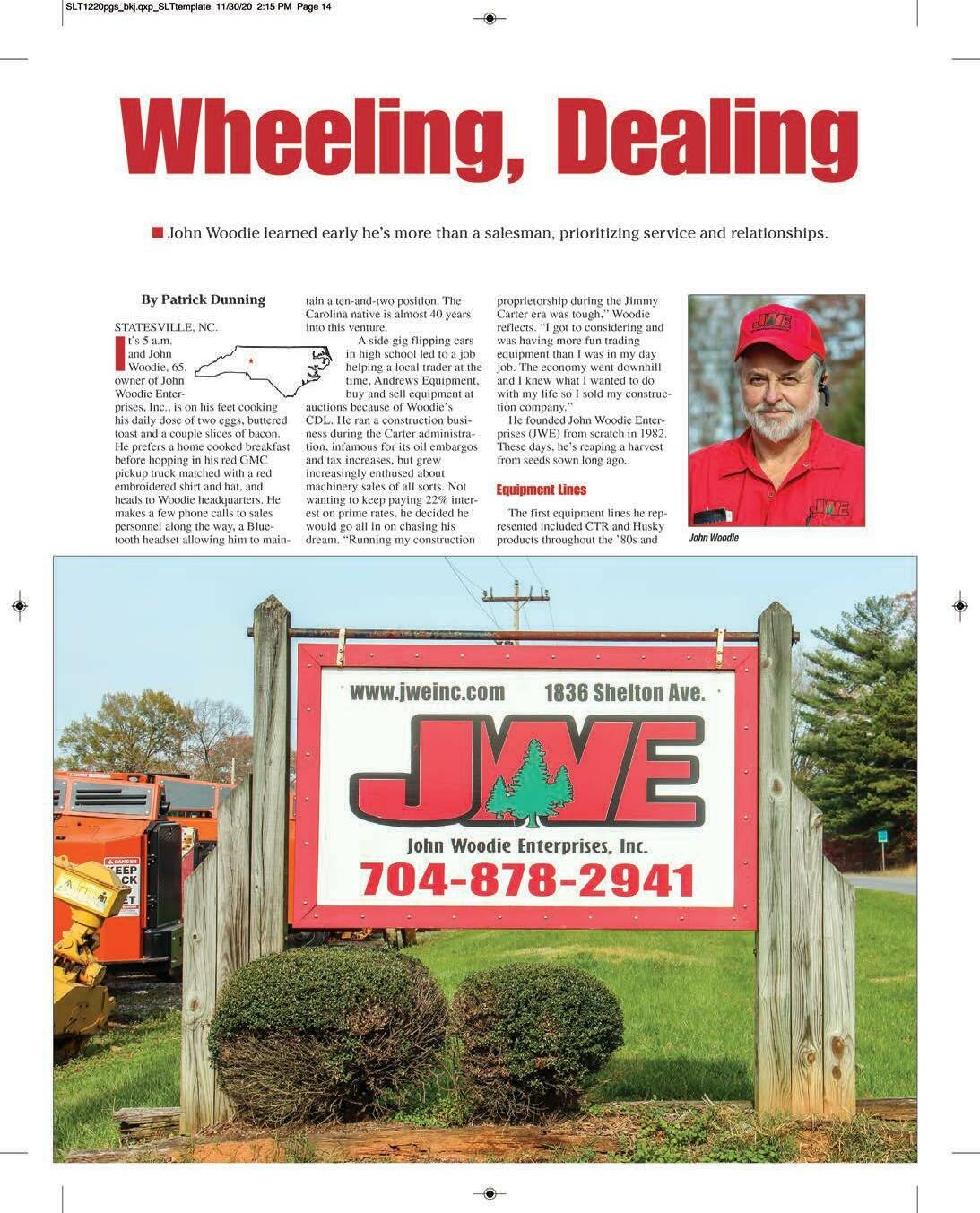




■
over the




Ox-y-mo-ron: a figure of speech in which apparently contradictory terms appear in conjunction and are self-contradictory. Such as Responsible Government, in this case—Forest Management.
Washington, DC has been described as embodying the best of Northern hospitality and Southern ingenuity. Not necessarily the epitome of functionality. On “Earth Day” President Biden signed an Executive Order directing the Forest Service and Department of Interior to “define, identify and complete an inventory of old-growth and mature forests on Federal lands.”
It is the “defining” of old-growth and mature timber where the concern should be for the forestry professionals and forest products industries. The variations in regions, species, management practices and numerous other factors create such a level of ambiguity (the quality of being open to more than one interpretation; inexactness) that it is impossible to define
a single standard. Hence, defining the undefinable and the oxymoron—defining ambiguity.
Regardless “Old-Growth” has been employed by antiforest management groups to obstruct forest management to the point of predisposing millions of acres to burn annually. All in the name of protecting the forests. Now throw “Mature Forests” into the equation.
The Climate Forests Coalition, a group of dozens of environmental organizations including Environment America, the National Resource Defense Council, the Center for Biological Diversity, and the Sierra Club prepared a report claiming that logging is the greatest threat to mature and old-growth forests.
The objective of this exercise in defining Old-Growth and Mature Forests is evident: further obstacles to federal forest management. Significant restrictions and limitations already exist regarding old-growth forests on federal land. The addition of the new category of “Mature
Forests” opens a pandora’s box that would create a new weapon in the arsenal of regular legal challenges to federal forest management efforts.

“Commercial forests are often grown to maturity and then harvested before they reach old-growth status.”
Len Montgomery, Environment America Public Lands Director

The irony of this statement is very revealing in that it would advocate that “mature” timber not be harvested in order to allow it to reach “oldgrowth” status, at which time it cannot be harvested either. This would suggest that timber should be harvested before it reaches maturity, which would be contrary to the position that mature timber is necessary to develop old-growth timber because, under that premise, immature timber must be protected to allow it to become mature timber and later old-growth timber.
Hence, under the guise of oldgrowth and mature forest scrutiny, no timber harvest on public lands is the ultimate objective of opponents of professional forest management.
For a government that professes to
follow the science, I would suggest that they consider silviculture. Generally, silviculture is the “science” and art of growing and cultivating forest crops, based on a knowledge of silvics (the study of the life history and general characteristics of forest trees and stands, with particular reference to local/regional factors). The focus of silviculture is the control, establishment, and management of forest stands. The primary benefits of silvicultural practices are: it produces abundant raw materials for the forest products industry; it increases forest cover, which is necessary for the conservation of wildlife; and it maintains a perfect water cycle in nature.
The practice of silvicultural-based forest management identifies the process as a stand that is tended, harvested, and re-established. Silviculture is a cycle that requires all aspects of the process to be completed. The harvest age class cycle is based on maturity, which varies from region and species.
The science of silviculture identifies the optimal point, and maturity, at which timber should be harvested. Mature trees are those that have reached their maximum product value, or the point where vigor, health

or growth are declining. Harvesting timber after the point of maturity renders dead, rotten and diseased forests that are prone to diminish the merchantable value.
Therefore, any consideration defining Mature Forests and Old-Growth Forests must be based on the science of silviculture and not an environmental agenda of no timber management or harvest. The latter is not scientifically based and is an obvious attempt at creating another false
premise to obstruct science-based silviculture forest management practices.
“You must remember that the forest which contributes nothing to the wealth, progress, or safety of the country is of no interest to the government.”President Theodore Roosevelt, America’s “Conservation President,” 1903 speech to the Society of American Foresters, the USDA and the DOI.
This is an exercise in semantics
that will accomplish nothing positive toward the forest management goals and objectives of the United States. Implementation of language defining “Mature Forests” will, on the contrary, create forests which contribute nothing to the wealth, progress or safety of the country, and should be of no interest to the government.
In conclusion, if the USDA/USFS and DOI were to dangerously attempt to define “Mature Forests” without basing it on the facts and science, it is
merely a pandering exercise in futility that would contribute nothing to the objective of improving forest health and reducing wildfires by forest professionals, but instead would result in another obstruction to federal forest management objectives and healthy forests.
Scott Dane is Executive Director of the American Loggers Council. ALC is a 501(c)(6) trade association representing the interests of timber harvesting and timber hauling businesses across the United States. For more information visit www.amloggers.com.


Canadian-based Peak Renewables plans to build a 180,000 metric tons per year wood pellet mill in Dothan, Ala. The $30 million project will utilize residuals from Rex Lumber sawmills in the area.
Construction on the facility is expected to be completed by mid2023. Peak is building the plant adjacent the SmartLam cross laminated timber plant in Dothan.
SmartLam recently announced it will add a $50 million glulam plant at its Dothan site. It will be capable of producing 84MMBF annually at full production.
Enviva Inc., announced the establishment of the Enviva Heirs Property Fund (EHPF), an initiative dedicated to ending involuntary land loss across the U.S. Southeast. Enviva has formally committed $250,000 on an annual basis to pro-



vide support to landowning families in the U.S. Southeast through direct financial support for professional services, identifying pathways for families to capture sustainable land value, and through public policy advocacy at the state and federal levels.
EHPF’s efforts will begin in 2022 in Mississippi and North Carolina, and will expand to include direct financial aid to landholders incrementally throughout Enviva’s operational footprint in the coming years,
in addition to the national policy work currently underway.
The issue of heirs property predominantly affects Southern black landholders, and has been a significant driver of black land loss over the last century. The Federation of Southern Cooperatives, a non-profit association of black farmers, landowners and cooperatives, estimates that 60% of African American-owned land in the South is held as heirs property, and from 1910 to 2007 it is estimated
that black farmers lost approximately 80% of their land, from about 20 million acres to about 1.9 million acres today.
To eliminate the systemic hurdles resulting in involuntary land loss, the Fund will act on the following three functions for landowners:
l Achieve Clear Title: Assist landowning families in achieving clear title to their land, thus removing the land from being vulnerable to involuntary loss. EHPF will connect families with the professional services necessary to secure clear and marketable title.

l Unlock Sustainable Value from Land: Assist families in receiving value from their land for generations, which they are unable to do until they achieve clear title. Through existing partnerships, EHPF will connect, educate and train families on resources and topics related to best practices for forest/land management, sustainable farming techniques, and merchandising. In parallel, EHPF will help families connect with the broad universe of federal and state benefits to landowners that hold acreage in clear title, such as grants for growing crops or building on their land, federal loans, and other governmentally bestowed benefits.
l Advocate for Changes in Public Policy: Advance policy solutions at the state and federal level to prevent involuntary land loss. EHPF will partner with several organizations that specialize in land loss prevention policy to resolve the ongoing sys-
temic land loss problem across the American South.
Industrial wood pellet producer Enviva reported several operational developments in its second quarter statement.
John Keppler, chairman and CEO, noted the company recently commenced construction of its plant in Epes, Ala.; is making swift progress on plans to start construction of a new plant in Bond, Miss.; and has recently filed for a permit for expansion of its Ahoskie, NC plant.

Enviva also emphasized that European Union policymakers are currently updating the Renewable Energy Directive (RED III), which was put in place in 2009 and revised in 2018 (RED II), and establishes common rules and targets for the development of renewable energy across all sectors of the economy to help the EU reach its ambitious energy and climate goals. These were increased by the European Green Deal with the goal of reducing net greenhouse gas emissions by 55% by 2030.
RED III is part of a package amending or creating 15 climate and energy laws to increase and accelerate climate mitigation, which includes reviewing existing criteria for sustainable biomass. The final law will be a negotiated piece of legislation reflecting a compromise position of the “trilogue” which includes the EU Parliament, EU Council of Ministers (“Council”), and EU Commission. Both the Council and the Commission have published proposals and positions on RED III which outline which renewable energy sources qualify for subsidies and keep the biomass sustainability framework from RED II largely intact. The proposal from the EU Parliament will likely be finalized this fall in a plenary session.
According to leading scientific advisory panels and policy makers, in order for the EU to reach their objective of climate neutrality by 2050, biomass use in power and heat plants alone will need to double.
Enviva is making solid progress on its path to more than double production capacity over the next five years, from 6.2 million MTPY to approximately 13 million MTPY. Enviva’s Lucedale, Miss. plant, the first plant in Enviva’s “Pascagoula Cluster,” continues to ramp production, and is on track to reach nameplate capacity of 750,000 MTPY by the end of this year. Recently, Enviva commenced construction of the fully contracted 1.1 million MTPY plant in Epes, Ala., the second plant in the Pascagoula Cluster. The third
plant will be built in Bond Miss., subject to receiving the necessary permits.

Strategic Biofuels announced that the Port of Columbia, home to the Louisiana Green Fuels (LGF) project, has been awarded a $1 million grant from the Dept. of Homeland Security (DHS) and FEMA through its Port Security Grant Program (PSGP).
The PSGP is part of a series of grant programs created by Congress and implemented by DHS to help strengthen defenses around the nation’s critical infrastructure. The PSGP specifically provides funds to state, local, territorial, and private sector partners to help protect portwide risk management and transportation infrastructure in support of the National Preparedness Goal.
A total of $100 million was awarded under the Port Security Grant Program to 213 recipients across the country. The $1 million awarded to the Port of Columbia was the largest award to the 15 Louisiana recipients.
The LGF project has continued to benefit from the State of Louisiana

Louisiana based Amerisafe Ins.Co.recognized Danny Britt Logging Inc.of Kirby,Ark.for having no worker’s comp claims for 20 years. Danny,holding certificate,has been a logging contractor for 45 years and has received numerous awards during his logging career.Also pictured are,left to right,AGAI account executive Joshua Bergen,skidder operator Ronnie Barrett and loader operator Taylor Moore.


and federal government’s desire to support Carbon Capture and Sequestration (CCS) innovation and development to meet climate goals. Strategic Biofuels has been a leader in Louisiana since successfully completing the first CCS test well last summer. Most recently, the federal Inflation Reduction Act enacted August 16, 2022 increased the IRS Section 45Q sequestration tax credits the project will receive on the approximately 1.4 million tons per year of CO2 it will sequester from $50/ton to $85/ton.
In addition, on August 1, Act 163
signed by Louisiana Governor John Bel Edwards went into effect, expanding the eminent domain acquisition of the port rights necessary for underground CO2 storage in Caldwell Parish and directly supporting the LGF project.
Louisiana Green Fuels will produce renewable diesel fuel from Renewable Fuel Standard compliant forestry waste and will produce all its own green power from sawmill and forestry waste materials. The plant and its accompanying Class VI Carbon Capture and Sequestration (CCS) wells will produce renewable diesel
fuel with a carbon footprint that is nearly a 400% reduction compared to fossil diesel, making it the most deeply carbon-negative liquid fuel in the world.
Robert “Bob” Lee Vermeer, who drove the growth of Vermeer Corp. and its line of whole tree chippers and other wood processing equipment, died on August 17. He was 78. His vibrant love of people, passion for Christ, distinct laugh and desire to put others first is what those who knew him will remember most.

Born in Oskaloosa, Ia. to Gary and Matilda Vermeer, Vermeer grew up on a family farm near Pella, Ia. where his love for the outdoors, animals and life on the farm was evident.
From an early age, he loved spending time with his parents and two siblings, Stan and Mary. They grew up watching their father and
founder of Vermeer, Gary Vermeer, build a company based on values while innovating better ways to do work on the farm.



After high school, Bob attended Dordt College for a two-year degree.
He transferred to Central College, graduating in 1966. His first job out of college was working at Marion County Bank, working there until 1973, eventually serving as Vice President and Director.
In 1968, Vermeer married Lois DeJong and they raised three children—Daniel, Heidi and Allison— in Pella.
Bob joined Vermeer in 1974 and held multiple roles that drove the
business strategy and long-term growth of Vermeer, including as CEO beginning in 1989 and later Co-CEO in 2003. He also served as Chair of the Board from 1989 through 2014. It was during his tenure that the business grew to more than 60 countries on six continents with an amazing team of employees and products supported by hundreds of dealers around the world. On the family side, Bob was a leader in promoting succession planning to transition the business to future generations of the Vermeer family.
He was committed to countless philanthropic endeavors as President of the Vermeer Charitable Foundation. The Foundation’s efforts have improved the lives of people throughout local communities, the State of Iowa and worldwide. Bob and Lois were charter and long-term member of Faith Christian Reformed Church. In 2007, the Bob Vermeer Spirit of Caring award began as a recognition of the important company culture Bob helped build. The award celebrates team members who demonstrated that culture both at work and beyond.




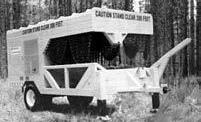
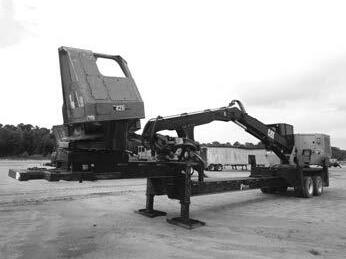


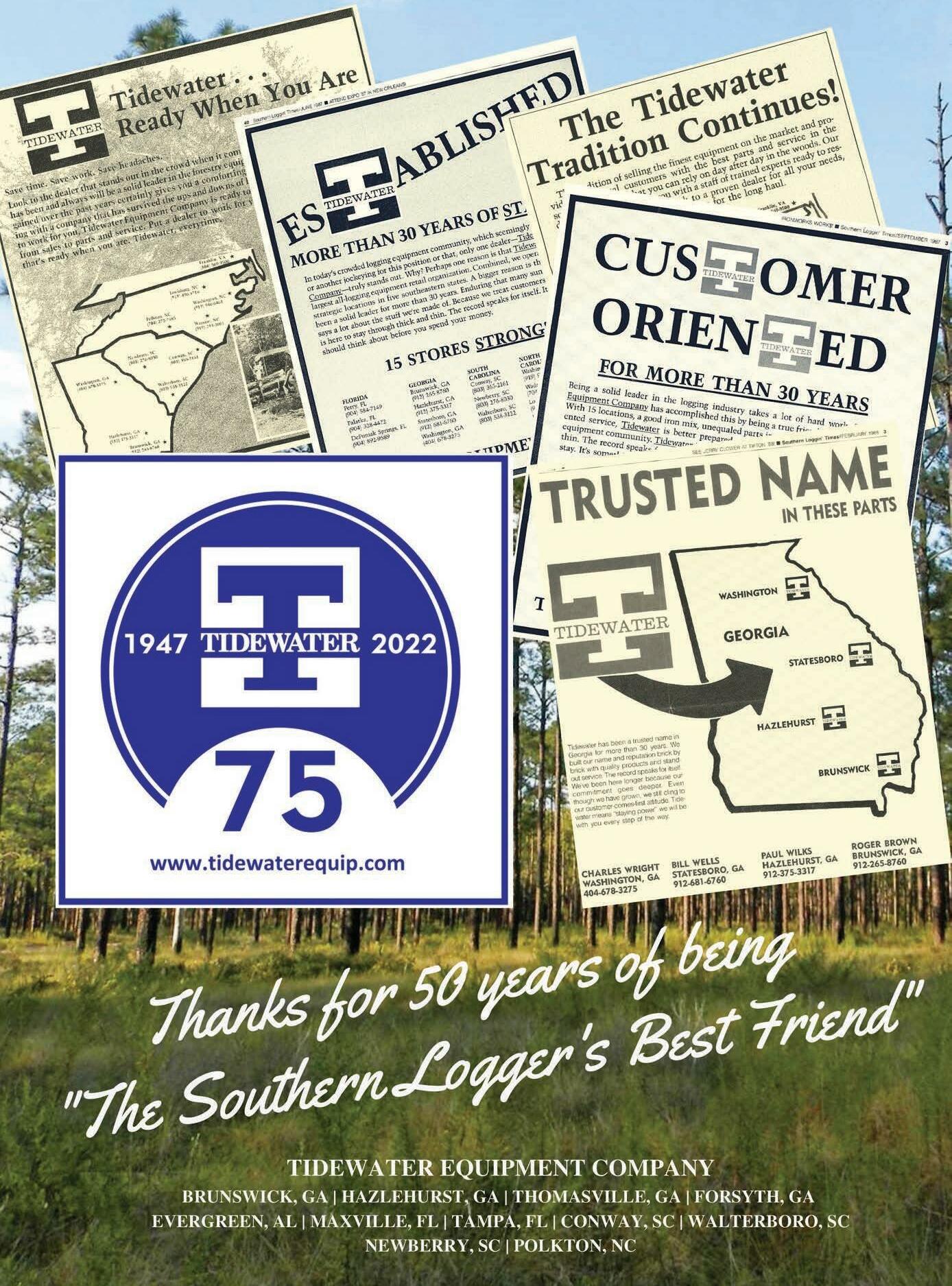

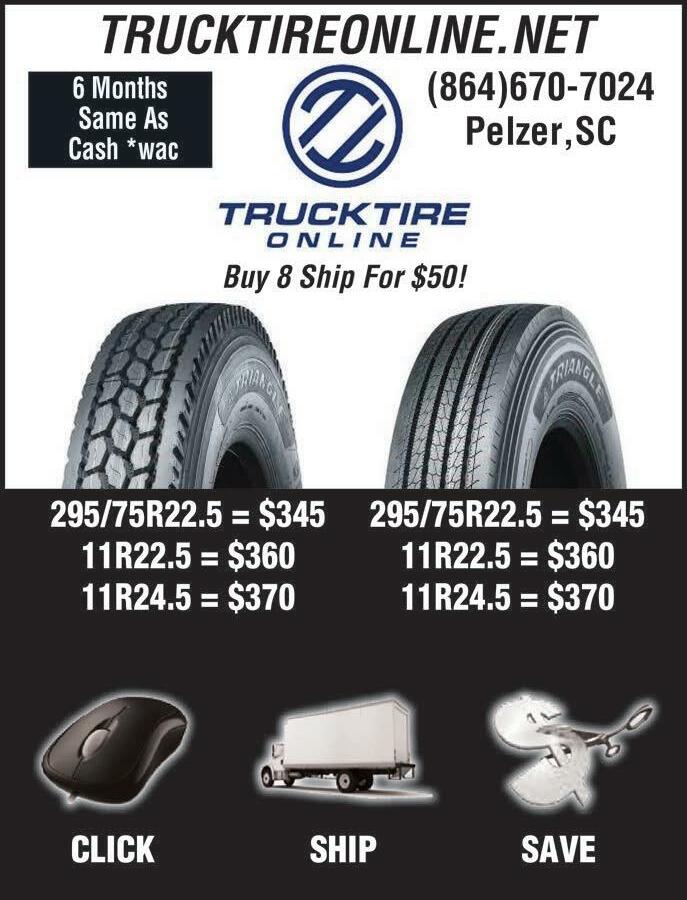

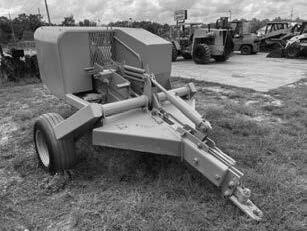

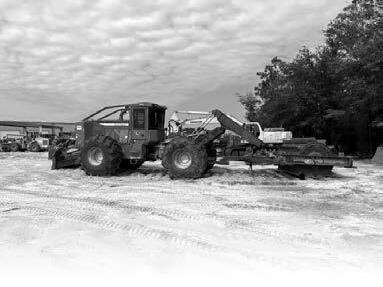




Loggers
Truck Parts
Around The World Salvage
Bandit Industries
Big John Trailers
BITCO Insurance
Caterpillar Dealer Promotion
John Deere Forestry
Despino Tire
Eastern Surplus
Firestone Agricultural Tire

Equipment
FMI Trailers
Chain
Forestry First
Forestry Mutual Insurance
G & W Equipment
Hawkins & Rawlinson
Interstate Tire Service
John Woodie Enterprises
Trailers
Komatsu Forestry Division
Mike Ledkins Insurance Agency
LMI-Tennessee
Loadrite Southern Star
Logger Associations

Magnolia Trailers
Maxi-Load Scale Systems
Midsouth Forestry
Logging
Morbark
Pitts
Ponsse
Prolenc
Quality Equipment
Southern Loggers
Stribling
Tidewater Equipment
Tigercat
VPG
Waratah
Yancey
202.627.6961
888.383.8884
936.634.7210
800.952.0178
800.771.4140
800.475.4477
919.550.1201
800.503.3373
318.445.4561
855.332.0500
515.242.2300
229.888.1212
601.508.3333
800.288.0887
803.708.0624
800.849.7788
800.284.9032
888.822.1173
864.947.9208
704.878.2941
336.790.6807
888.285.7478
800.766.8349
800.467.0944
256.270.8775
800.738.2123
877.265.1486
870.226.0000
888.754.5613
800.831.0042
800.321.8073
715.369.4833
877.563.8899
800.668.3340
386.487.3896
318.445.0750
855.781.9408
912.638.7726
519.753.2000
601.635.5543
800.237.0022
770.692.0380
601.693.4807
334.264.3265
800.282.1562
5-7—Tennessee Forestry Assn. annual meeting, Paris Landing State Park Lodge, Buchanan, Tenn. Call 615883-3832; visit tnforestry.com.
Arkansas Forestry Assn. annual meeting, DoubleTree, Little Rock, Ark. Call 501-374-2441; visit arkforests.org.
26-28—Texas Forestry Assn. annual meeting, Texas A&M Hotel and Conference Center, College Station, Tex. Call 936-632-8733; visit texas forestry.org.
2-4—Forestry Assn. of South Carolina annual meeting, Westin Hilton Head, Hilton Head Island, SC. Call 803-798-4170; visit scforestry.org.
22-26—Appalachian Hardwood Manufacturers annual meeting, Ponte Vedra Inn & Club, Ponte Vedra, Fla. Call 336-885-8315; visit appalachianhardwood.org.
24-26—South Carolina Timber Producers Assn. annual meeting, DoubleTree Resort by Hilton, Myrtle Beach, SC. Call 800-371-2240; visit scloggers.com.
8-10—2023 SLMA & SFPA Spring Meeting & Expo, Hyatt Regency Savannah, Savannah, Ga. Call 504443-4464; visit slma.org.
28-30— Kentucky Forest Industries Assn. annual meeting, Embassy Suites, Lexington, Ky. Call 502-695-3979; visit kfia.org.
30-April 1—Southeastern Wood Producers Assn. annual meeting, The Okefenokee Fairgrounds, Waycross, Ga. Call 904-845-7133; visit swpa.ag.
17-20—Virginia Loggers Assn. annual meeting, Hotel Roanoke, Roanoke, Va. Call 804-677-4290; visit valoggers.org.
23-25—Forest Products Machinery & Equipment Expo, Music City Center, Nashville, Tenn. Call 504443-4464; visit sfpaexpo.com.
15-16—Kentucky Wood Expo, Masterson Station Park, Lexington, Ky. Call 502-695-3979; visit kfia.org.
17-18—Expo Richmond 2024, Richmond Raceway Complex, Richmond, Va. Call 804-737-5625; visit exporichmond.com.
20-23—IWF 2024, Georgia World Congress Center, Atlanta, Ga. Call 404-693-8333; visit iwfatlanta.com.

